This is a fantastic itinerary for a two-month, self-drive trip – primarily through Spain and Portugal – plus a quick visit to some very beautiful regions in southern France, Germany and Switzerland.
While we travelled fairly quickly, the itinerary can be tailored to be longer or shorter, depending upon the time available.
Itinerary:
Munich – Geneva – Lyon – Dordogne region – Bayonne – Bordeaux – San Sebastian – Bilbao – Leon – Salamanca – Duoro Valley – Porto – Coimbra – Obidos – Lisbon – Sintra – Evora – Vila Nova de Milfontes & West Coast Portugal – Algarve – Seville – Ronda – Granada – Cordoba – Madrid – Toledo – Segovia – Montpellier – Aix en Provence – Sainte Maxime – Saint Tropez – St Paul de Vence – Lake Maggiore – Interlaken – Neuschwanstein Castle – the Romantic Road (Fussen to Wurzburg) – Rhine River (Wurzburg to Koblenz) – Strasbourg – Alsace Wine Route – Colmar – Geneva
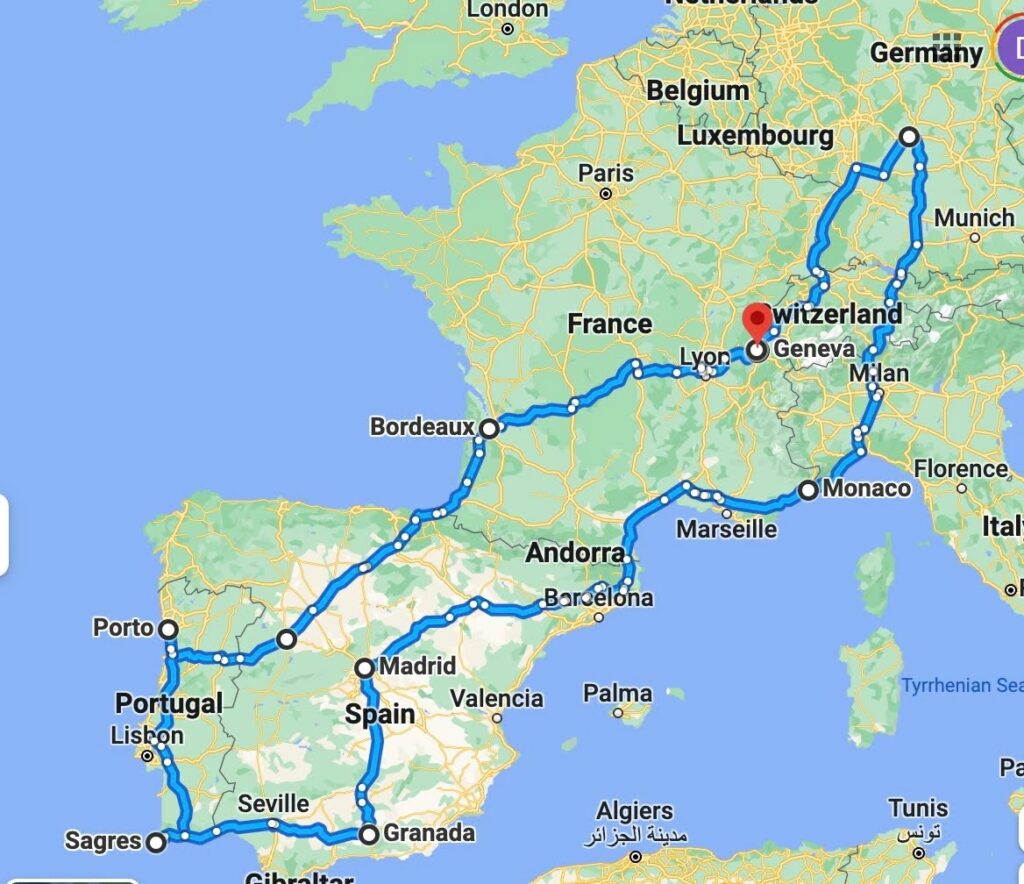
SLIDESHOW
For a photo tour of our itinerary take a look at our Europe slideshow.
WHERE TO LEASE A CAR: DRIVEAWAY – EURO-LEASING
After much research, we found the best option for hiring a car for a long rental (two months in our case) seemed to be Euro-Leasing through DriveAway
We leased a Peugot 5008. We had, in fact, asked for a smaller Peugeot however on arrival we were upgraded to a 5008. Whilst a very comfortable vehicle, it would have been preferable to have a smaller car to navigate some of the narrow streets in European towns and villages.
From Australia we flew into Munich and took a train to Geneva where we collected the car to begin our drive towards northern Spain.
We chose to collect and drop off the car in Geneva (French side), mainly because Geneva is located in central Europe and gave options to travel north or south.
MUNICH, GERMANY
Accommodation: B&B Hotel Munchen Hbf
For an introduction to Munich, we took the 10.30am Free Walking Tour of Munich with Heart of Munich Tours .
During this 2.5-hour tour of the Old City we heard the history of the city, local legends and anecdotes, etc – highly recommended as a starting point on your visit to Munich.
While 90% of the city was destroyed during WWII, it has been beautifully restored, and we loved our time there.
Our suggestions on what to see and do in Munich:
- Marienplatz – beautiful square, heart of the Old City (the Altstadt) where you will see the Old Town Hall and the New Town Hall – famous for the Glockenspiel clock (the clock is not automated, someone operates it manually every day!).
- Cathedral of Our Lady (Frauenkirche)
- Odeonsplatz – a large square with notable sights including the Field Marshall’s Hall (Feldherrnahlle), the Theatiner Church, the Residenz Palace (Royal Residence Palace), the Hofgarten Park (formerly the palace gardens).
- Royal Residence Palace in Odeonsplatz is now a museum.
- Max Joseph Plazt – an attractive city square that is home to the National Theatre.
- Hofbrauhaus – famous beer hall.
- Food market (Viktualienmarkt) – a popular fresh food market plus souvenirs (closed Sundays).
- Graggenau – beautiful neighbourhood in the Old Town.
- St Peter’s Church – oldest Catholic church in Munich where you can climb the tower for views of the city.
- The English Gardens – don’t miss the surfboard riders surfing the waves of the Eisbach – near the art gallery (Haus der Kunst) on Prinzregentenstrasse.
- Deutsches Museum – one of the largest science and technology museums in the world.
- BMW Museum
- Visit the trendy and pretty neighbourhood of Gartnerplatz with some great restaurants. We ate at Jack Glockenbach Vietnamese Restaurant – highly recommended.
Time permitting, day trips from Munich include Dachau Memorial Camp and Neuschwanstein Castle.
If you are interested in history, Heart of Munich also offer a Third Reich Walking Tour in Munich.
GENEVA, FRENCH SIDE: COLLECT CAR
Accommodation: B&B Hotel Geneva Airport
From Munich we took the train to Geneva. Geneva was just an overnight stay to collect our car from DriveAway.
LYON, FRANCE
Accommodation: B&B HOTEL Lyon Caluire Cité Internationale
After collecting our car in Geneva, we drove south to beautiful Lyon. We had hoped to have two days in Lyon but a demonstration and road closures resulted in just one day (much too short) in this lovely city.
Lyon has much to see. It is a vibrant city offering a blend of history, culture and cuisine – it is often considered the gastronomic capital of France.

Place des Terreaux, Lyon
The city is characterised by its beautiful architecture, with a mix of ancient Roman ruins, medieval and Renaissance buildings, and 19th Century boulevards.
To orientate ourselves, we took a Lyon City Tour – Hop On, Hop Off bus tour – the route and the commentary were very good, and we can recommend this tour as a good introduction to Lyon.
We also recommend Free Tour Lyon walking tours. There are a couple of tours – one is the Free Tour of Vieux Lyon and the other is Free City Tour Lyon.
We spent most of our time exploring the UNESCO World Heritage listed Presqu’ile area – the heart of Lyon – beautiful architecture, charming streets, smart boutiques and numerous restaurants.
Our suggested highlights of Lyon:
- Place des Terreaux – the main square of Lyon where you will see the Fountain de Bartholdi, Musee des Beaux Arts and Hotel de Ville.
- Musee des Beaux Arts – visit the Museum of Fine Arts to see one of the largest collections of European art, spanning ancient Egypt to present day, including works by Picasso, Monet, Rembrandt and Van Gogh.
- Lyon Opera House – located in a beautiful square in the Presqui’le district.
- Vieux Lyon (Old Lyon) – explore the charming narrow streets of Vieux Lyon, a UNESCO World Heritage site. Admire the well-preserved Renaissance architecture, visit traboules (hidden passageways that connect streets and courtyards).
- Croix-Rousse – explore this historic district known as the silk-weaving centre of Lyon. Visit the Maison de Canuts (Silk Workers House) to learn about Lyon’s silk industry.
- Les Halles de Lyon Paul Bocuse – sample Lyon’s culinary delights at Les Halles de Lyon Paul Bocuse, a covered food market named after the legendary French chef. Sample local specialities from the market’s numerous vendors.
- Place Bellecour – one of the largest pedestrian squares in Europe. The Hop On, Hop Off bus tour begins here. The Tourist Information Office is located on the square.
- Rue de la Republique – the main shopping street of Lyon, between Place des Terreaux and Place Bellecour
- Fourviere Hill – to see the magnificent Basilica of Notre Dame de Fourviere and the Ancient Theatre of Fourviere and museum.
- Basilique Notre-Dame de Fourviere – this magnificent basilica located atop Fourviere Hill, offers panoramic views of the city.
- Hop on Hop Off Bus Tour – excellent, clear audio and good commentary. The bus is a good way to get up to Fourviere Hill.
There are also many wonderful museums in Lyon including the Museum of Fine Arts, Musee du Cinema et de la Miniature, Confluences Museum, Musee Lumiere.
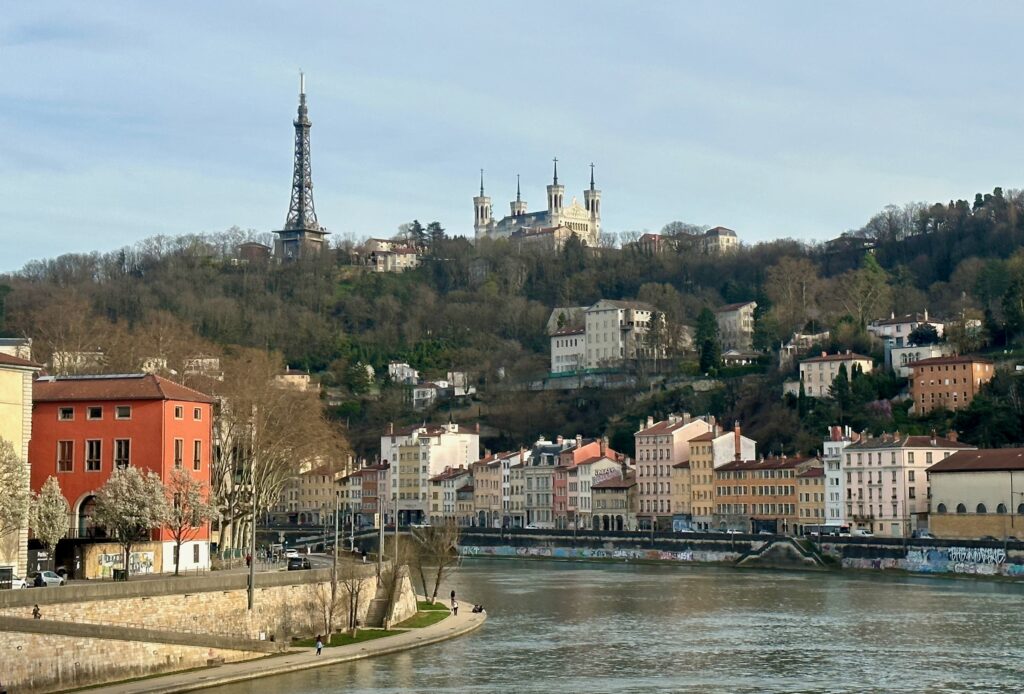
Lyon
We loved our time in Lyon but it was far too short.
SARLAT LE CANEDA & THE DORDOGNE REGION OF FRANCE
Accommodation: O’Myosotis Bed & Breakfast
Beautiful accommodation and highly recommended. Well located just a few moments walk from centre of village, charming host and lovely room. We enjoyed a French meal at Restaurant L’Esprit, Sarlat – about a 20 minute walk from our accommodation.
It was quite a long drive from Lyon to Sarlat (six hours), where we decided to base ourselves in the Dordogne region.
Sarlat is a very charming medieval village – it makes a perfect base from which to explore the Dordogne. There are many day trips to be made – medieval castles, prehistoric art, caves, villages, gardens and more.

The Marqueyssac Gardens
Sarlat and the Dordogne region was one our favourite places in Europe. There is much to see and do and in a few days we only scratched the surface.
Suggested highlights:
- Wander and explore the beautiful streets of Sarlat. On Wednesdays and Saturdays there is a fabulous food market.
- Take a drive through the countryside visiting beautiful villages of Vezac, Beynac-et-Cazenac, La Roque-Gageac, Domme, Campagne, Les Eyzies-de-Tayac, Saint-Leon-sur-Vezere, Coly-St-Amand, Collonges-la-Rouge and Martel.
- Many towns and villages in the Dordogne have local markets – well worth a visit.
- Chateau & Jardin des Milandes – former residence of Josephine Baker.
- Marqueyssac Gardens & Chateau – amazing topiary gardens.
- Castle of Castelnau-Bretenoux – 800 year old fortified castle, a French National Heritage Monument.
- The Dordogne and the the Vézère valley (Valley of Man), are famous for prehistoric sites and artwork, many of which are UNESCO World Heritage listed – see Prehistoric sites and Prehistory in the Dordogne for more details.
- Lascaux IV – International Center for Cave Art and replica of the Lascaux cave.

Sarlat-la-Caneda
For detailed information on what to see and do in the Dordogne visit the Visit Dordogne Valley website or the Discover Perigord & the Dordogne website.
BAYONNE, FRANCE
We stopped in Bayonne for a few hours on our drive between Bordeaux (France) and San Sebastian (Spain) – we loved Bayonne and wished we had stayed at least one night. We recommend including a stay on your itinerary.
Located in French Basque country, close to the Spanish border, Bayonne is a very pretty medieval town. We didn’t see any of the tourist spots, we just wandered through the beautiful cobbled streets, admiring the colourful half-timbered buildings, strolled along the river and enjoyed the lovely shops. It was one of our favourite towns.
Parking is easy – there are open carparks just outside the old town (very short walk into the centre), close to the excellent Tourist Information Centre.

Bayonne
For more information on what to see and do in Bayonne visit the Bayonne Tourist Office website.
BORDEAUX, FRANCE
Accommodation: La Villa Bocage – beautiful guest house accommodation. Chrystèle is a charming host and serves a delicious breakfast. A very special place. Highly recommended. A good place to eat nearby is Bibibap Korean Restaurant.
Bordeaux is a beautiful city with gorgeous neo-classical architecture. We also loved the medieval district.
As an introduction we recommend the Free Walking Tour Bordeaux.

Place de la Bourse overlooking the Miroir d’Eau reflecting pool, Bordeaux
Recommended:
- Monument aux Girandins Fountain
- Opera House (unfortunately the tours that go into concert hall are only in French) but worth going into foyer.
- International Grand Hotel de Bordeaux – bar on terrace on top floor.
- Church Notre Dame – see the statue of Goya who loved Bordeaux.
- Passage Sarget – beautiful Arcade – the first ‘shopping mall’.
- Bordeaux’s ‘Golden Triangle’ (bordered by Cours Clemenceau, Cours de l’Intendance and Allées de Tourny) is the heart of the city – high end shopping, beautiful neoclassical architecture.
- La Toque Cuivree for the best caneles – a delicious French pastry.
- Cathedral of St Andrew of Bordeaux and the Pey-Berland bell tower (it is possible to climb the bell tower for 6 Euros).
- Hotel de Ville on the same square as the Cathedral.
- St Catherine Street – the longest single pedestrian street in Europe.
- Medieval Bordeaux: wander the narrow streets between Eglise Saint Pierre (Church of St Peter which took over 200 years to complete) and Grosse Cloche (medieval gate) where the streets are named after what was sold. In Rue de Loup you can see one of the few remaining medieval houses left standing. Du loup means ‘of the wolf’ so perhaps wolf skins were sold here.
- Palace Square (Place du Palais) and the Porte Cailhau (medieval gate).
- Church of St Peter (Eglise St Pierre)
- Place de la Bourse overlooking the Miroir d’Eau reflecting pool.
- Cité du Vin (Wine Museum) – famous landmark in Bordeaux where you can learn everything you wanted to know about wine. A good place for lunch is Les Halles (food market) opposite.
- Bar a Vins – taste the wines of Bordeaux accompanied by local charcuterie, cheeses and chocolates in the Bar a Vins (just near the Tourist Office).
- Bordeaux Visiotour – we enjoyed this 70-minute bus tour which took us to sights outside the historic city centre.
- Day trip to St Emillion where there are more than 300 places for wine tasting in the charming village of St Emillion and surrounding wineries! At the wineries visitors usually have to do a tour and tasting together.
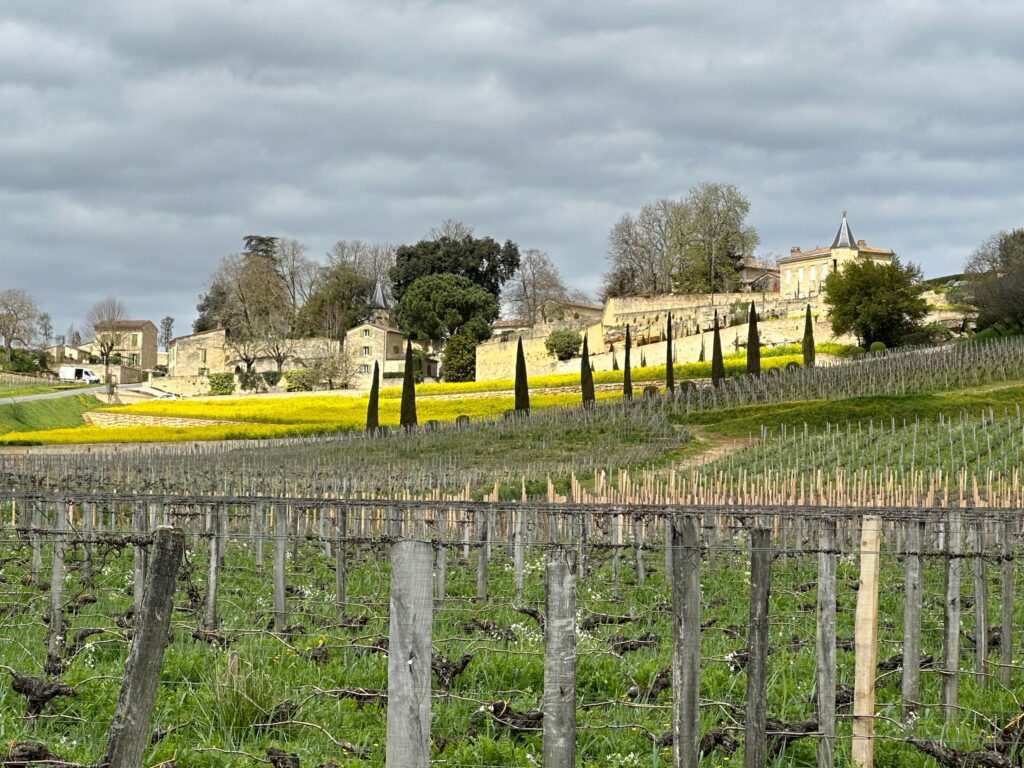
Saint-Emilion
For more information on what to see and do in Bordeaux visit the Bordeaux Tourism website.
SAN SEBASTIAN (Donostia), SPAIN
Accommodation: Hotel Trueba – a small, modern, well-located hotel in the trendy neighbourhood of Gros, about a 10-minute walk from San Sebastian old town. There are many good restaurants and bars close to the hotel. Secure underground parking was available in the carpark in Plaza Cataluna – a five minute walk from the hotel.

San Sebastian
To get to know a little about the city, we join a 10.30am Go Local Walking Tour of San Sebastian. We have an excellent guide who takes us through the old and new town, we learn about places to eat and drink, local customs, etc. We highly recommend this tour as an introduction to San Sebastian.
Suggestions on what to see and do in San Sebastian:
- Visit the Old Town (Parte Vieja) of San Sebastian:
- Constitution Square – beautiful main square in the old town
- Church of St Vincent (Basque Gothic) – the oldest in the city
- St Mary of the Choir Basilica (Basilica of Santa Maria) – on Calle Mayor – was the church of the wealthy.
- San Telmo Museum
- Try Pinchos (pintxos) – appetisers before dinner. Locals bar-hop spending about 6 minutes in each bar. A good selection of pinchos bars are found on and around Fermin Calbeton Kalea – a small street in the old town. Our guide pointed out some of the best pinchos bars – including Bar Borda Berri, Bar Sport, Gandarias, Bar La Vina and La Cuchara de San Telmo.
- Basque Cheesecake at Bar/Restaurante La Vina – delicious.
- Enjoy a meal at La Cuchara de San Telmo – located just off Fermin Calbeton Kalea (look for the sculpture of woman holding bricks above head) in a side street, this small bar serves delicious traditional dishes – we ordered beef cheeks and suckling pig – one of the best meals we had in Spain.
- Town Hall and Alderdi Eder Park – the town hall used to be a casino and the building is a copy of the Monte Carlo casino.
- La Concha Bay – the famous beach of San Sebastian
- Buen Pastor Cathedral
- San Sebastian Harbour
- De Okendo Plaza – the last stop on our walking tour – on one side is the beautiful Hotel Maria Cristina and on the other is Victoria Eugenia theatre – look for bullet holes in both buildings from the Spanish Civil War.
- Gros – visit this popular neighbourhood – lots of bars, restaurants, boutiques and the beach of La Zurriola. Our favourite restaurant in Gros was Bodega Donostiarra.
- Visit the Mercado building – fresh fruit and vegetables – where the local people shop.
- Monte Igueldo Funicular – lovely views of San Sebastian.
- Plaza Guipuzcoa Gardens – the oldest park in San Sebastian.

Bodega Donosstiara
GUGGENHEIM IN BILBAO, SPAIN
We took a day trip from San Sebastian to visit the Guggenheim Museum in Bilbao – highly recommended.
It is a very pretty drive to Bilbao. On arrival, the best parking station for visiting the Guggenheim Museum
is Plaza Euskadi car park, at a cost of Euro 5.45 for a couple of hours.
The Frank Gehry designed building is beautiful and it was a dream to be there. We spent a couple of hours in the museum and there were several exhibitions to see including Joan Miro, Oskar Kokoschka, Lynette Yiadom-Boakye and an installation by Japanese artist Yayoi Kusama. Exhibitions change regularly so it is best to check their website for current and future exhibitions.

Guggenheim Museum Bilbao
We had a delicious lunch at Bertiz bakery/coffee shop then did a quick drive around Bilbao – a lovely town, tree lined streets, gorgeous shops.
On the way back to San Sebastian we drove via the coastal road between Zumiai and Getaria – a beautiful drive between the two towns.
LEON, SPAIN
Accommodation: Inn Boutique Leon – new, modern, very close to cathedral and main square. Highly recommended.
Leon old town is a very beautiful town – highly recommended. We arrived during an Easter procession so it was very crowded and difficult to find parking. Under normal circumstances however, you could drive to the hotel, drop luggage and park in the town’s open carpark for free. We parked near Plaza Mayor, the main square of the old town in an underground carpark for a fee.
The main attraction in Leon is the magnificent Leon Cathedral – famous for the beautiful stained-glass windows. We took an audio tour of the cathedral – highly recommended.

Leon Cathedral
SALAMANCA, SPAIN
Accommodation: San Justo Plaza (an apartment) – modern, very well located with parking in private garage a couple doors away, highly recommended.
Salamanca is famous for its university – founded in the 1100’s. It is still a thriving university town.
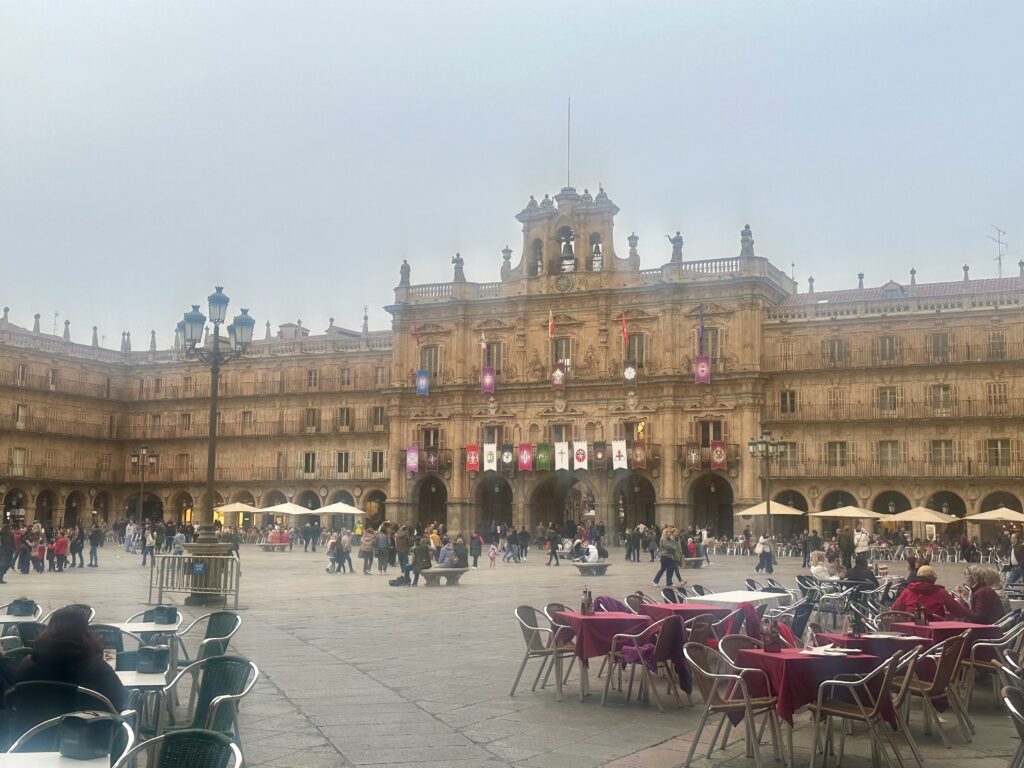
Plaza Mayor Salamanca
We took a fantastic Free Guided Walking Tour at 5pm – one and a half hours – highly recommended. Salamanca is such an interesting town with so many historic buildings that it is a good idea to take a tour to hear the fascinating stories behind those buildings.
Our guide recommended we continue on to see the old university building which we did (free today) – loved it. Highly recommended. Don’t miss the library on the first floor.
We also suggest walking across the old bridge for views back across Salamanca.
Don’t miss:
- Plaza Mayor – the central square of the city.
- House of Shells – now the public library, built as a private house in the late 15th Century.
- Old Cathedral & Gallo Tower (dome) and New Cathedral & Bell Tower – the new cathedral was added to the old cathedral. It took 200 years to build, between 1500 and 1700. Look for the unusual carvings added over the years – crayfish, hare, astronaut!
- St Stephen’s Convent cloisters.
- Pontifical University building.
- Vera Cruz church, 1506 is said to hold a relic of the Holy Cross.
- Take a walk across the Roman bridge for views back across Salamanca.
DUORO VALLEY, PORTUGAL
We drove from Salamanca, Spain to the Duoro Valley in Portugal, crossing the Spanish/Portuguese border.
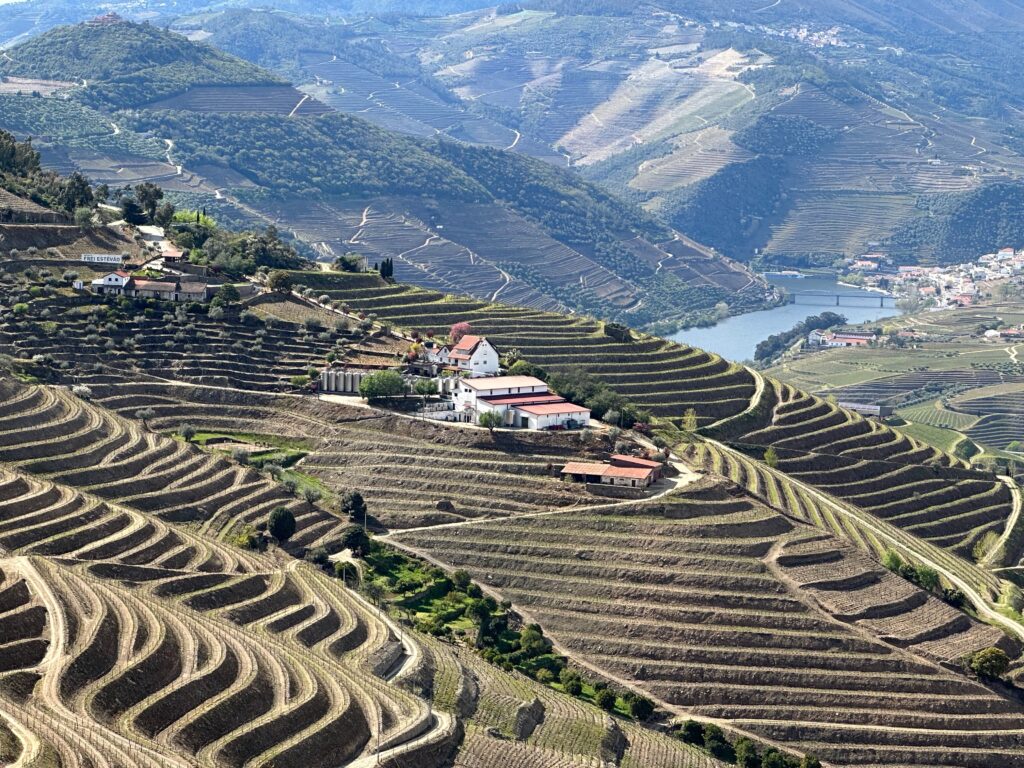
Duoro Valley
Highlights of that drive:
- From Lumbrales beautiful scenery.
- Beautiful orchards around Barca de Alva.
- Stop at the Museo do Coa (just outside town of Vila Nova de Foz Coa) – fabulous views, delicious lunch at the museum restaurant (Coa Museu Restaurante). Highly recommended.
- Particularly beautiful scenery on the N222 between Vila Nova de Foz Coa and Pinhao. Pinhao very pretty spot
- Scenic drive along N222 between Pinhao and Peso da Regua.
We stayed in the town of Peso da Regua.
Accommodation: Casa dos 4 Caminhos Guest House – new, modern house, immaculately clean. We had a twin room with bathroom (Room 3), shared kitchen/living, parking onsite behind a gate. We could walk back into the town. Accommodation provided a voucher for breakfast at a very nice bakery 200m away (opposite supermarket) – orange juice or coffee, a sweet pastry and a ham/cheese roll – delicious. Peso da Regua is on the Duoro River and makes a good base to do trips to the wineries. Alternatively we suggest staying at a winery (wineries are called Quintas) or stay in town of Lamego (see below).
The Duoro Valley is all about the scenery and visiting the quintas.
Recommendations:
- Quinta da Pacheca, tours and tastings, restaurant, accommodation in enormous wine barrels!
- Quinta de Santa Eufemia, tours, wine tasting.
- Quinta do Seixo (Sandemans), great views. Tours, wine tasting.
- Town of Lamego famous for the baroque stairway that climbs the steep Santo Estevao hill to the beautiful Nossa Senhora dos Remedios church (great views, beautifully lit at night). Recommended accommodation: O Cantinho do Colégio – Dourocollege, Rua dos Fornos 10, 5100-146 Lamego (free parking a few minutes away near the bus station). Recommend Casa da Rua – lovely family run restaurant.
- Caves Raposeira, sparkling wine (close to Lamego).
- Pinhao – on the river where all the boats arrive, hard to park. Lovely blue tiles at the station.
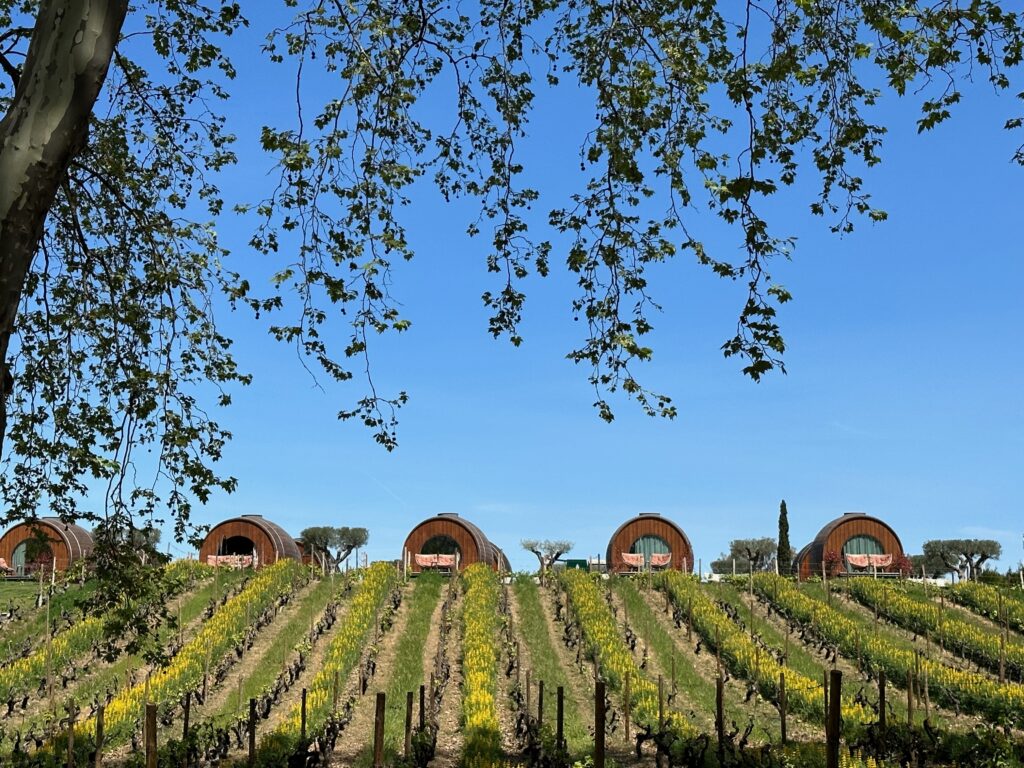
Accommodation in wine barrels, Quinta da Pacheca, Duoro Valley
PORTO, PORTUGAL
Accommodation: YourOpo Balhao Apartments – Rua Sa da Bandeira 393 – 397, União de Freguesias do Centro, 4000-435 Porto – we have apartment 2C on the second floor – lovely spacious apartment with small balcony facing street. There is an entry hall, large bedroom/living/full kitchen – in a lovely old building. Porto’s Food Market directly opposite. Can stop and drop off luggage, then park in carpark nearby (staff give you directions). Staff at hotel are wonderful – they meet with you and go through in detail what there is to see and do in Porto. Highly recommended.
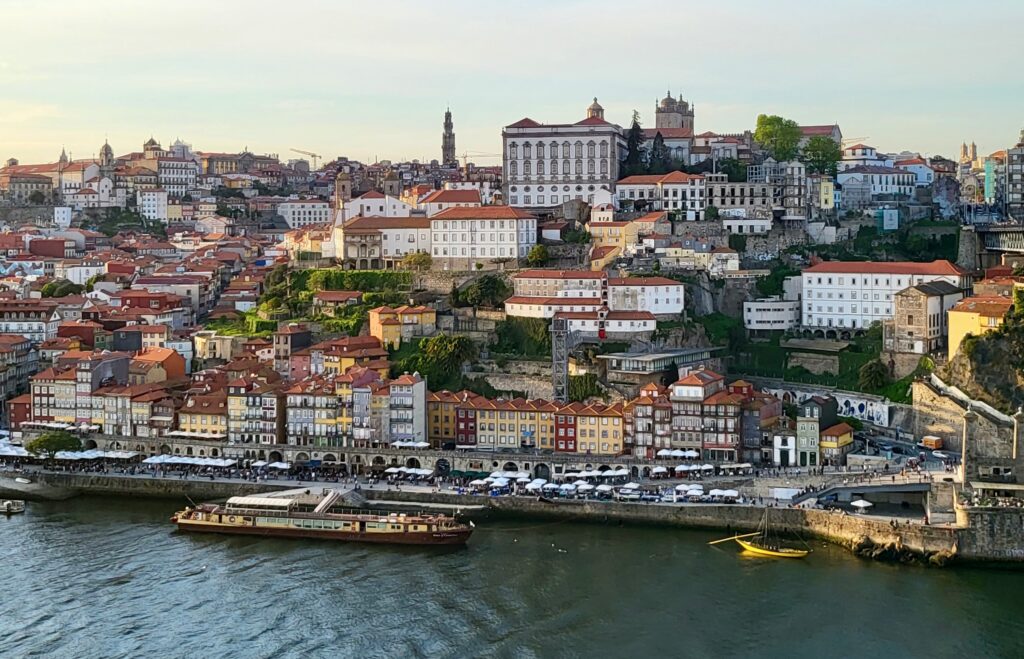
Porto
There is much to see in Porto – it’s a fabulous city.
Recommendations:
- Visit the Porto Food Market.
- Visit the Capela as Almas – lovely blue and white tiles cover the exterior.
- Stroll down the main shopping street (pedestrian street) – Rue da Santa Catarina. We loved Cafe Majestic.
- Igreja de Sto Ildefonso – blue tiles on front of building.
- São Bento Railway Station (Porto Railway Station) – exceptionally beautiful tiles inside.
- Have a look in McDonalds – it’s located in a beaux epoc style building.
- Cathedral and Bishops Palace.
- Ribeira area – lots of cafes lining the riverbank (more touristy and expensive than Gaia side), boat trips. See the coloured buildings at Ribeira.
- Walk to and over the upper level of Ponte Luiz I bridge – very high above the river, great views.
- Watch sunset from Jardin do Morro.
- Gaia – on other side of river – good place for restaurants and tasting port wine – many wine cellars on that side including Taylors and Ferreira. From Gaia there are lovely views back across to the old town of Porto.
- Visit Igreja de S Francisco and Palacio da Bolsa – Can take tourist tram along river to the beach – about 30-minute trip.
- Take stairs or funicular to get back up to Porto town. Cost of funicular 5 Euros.
- Walk along Rue das Flores in old town.
- Visit Jardin das Oliveiras.
- Visit Livraria Lello – ‘Harry Potter’ bookstore.
- Visit – Igreja das Carmelitas and Igreja do Carmo – two churches with little ‘house’ between.
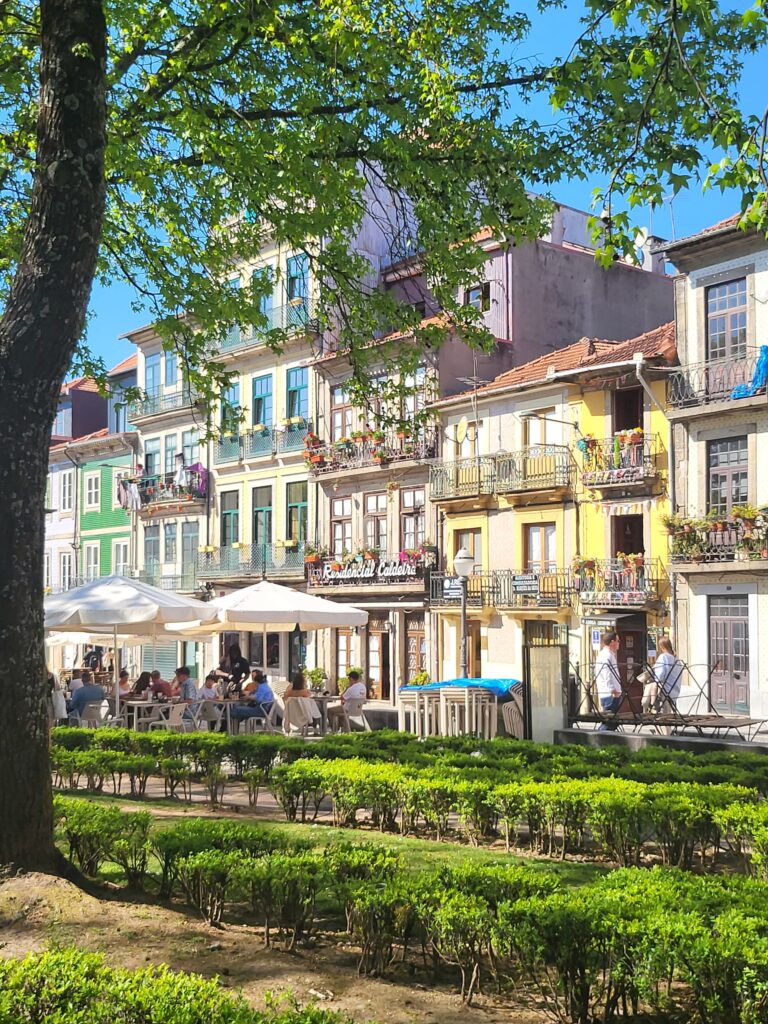
Campos dos Martires da Patria
Food recommendations:
- Café Majestic – try the chocolate cake
- Confeitaria Bolhao – good for breakfast and lunch
- Honest Greens mostly vegetarian (some meat choices too) in Rue Da Santa Catarina. Good value meals.
- Da Terra – vegetarian restaurant
- La Ricotta – Italian restaurant
We did two walking tours in Porto which we can highly recommend:
- Classical Porto Free Walking Tour – 11.45am for about 3 hours – Eastern side of the city centre – old town, historical content – guide is Lucas. We see Sao Bento Railway Station (hear the story of the blue tiles), Santa Catarina, Batalha, Bridge Luis I, Cathedral (Sé), Barredo neighbourhood, Ribeira quarter. The tour ends at “Ribeira quarter” (by the river).
- Porto Lifestyle Free Walking Tour – 3.30pm for about 3 hours – Western side of the city centre – more modern history and Porto life in XIX and XX century. We visited the Baixa area, home to the city’s nightlife; we hear about the 20th dictatorship, the 19th century civil war; Portuguese sailors; Lello bookshop (outside) inspiration for Hogwarts Library in Harry Potter; , University, Carmo and Carmelitas churches, Piolho cafe, Clérigos tower, Cordoaria garden, the Courthouse and former prison, Vitória view point, Virtudes garden, Miragaia neighborhood, S.Francisco church, Palácio da Bolsa, ending at Praça do Infante (Henry the Navigator monument).
COIMBRA, PORTUGAL
Accommodation: JR Studios & Suites I Rius I – highly recommended as it is just across the bridge from the old town area of Coimbra. We had room 212 – a cosy studio. There is a kitchen on the top floor and the patio off the kitchen has a wonderful view over Coimbra. We can also recommend a meal at the cafe next door – home-cooked delicious meals.
We recommend doing the Free Walking Tour – the Downtown Center and University Tour, tour guide Joao Mendes, duration 2.45 hours. There is so much history to Coimbra that the walking tour was invaluable.
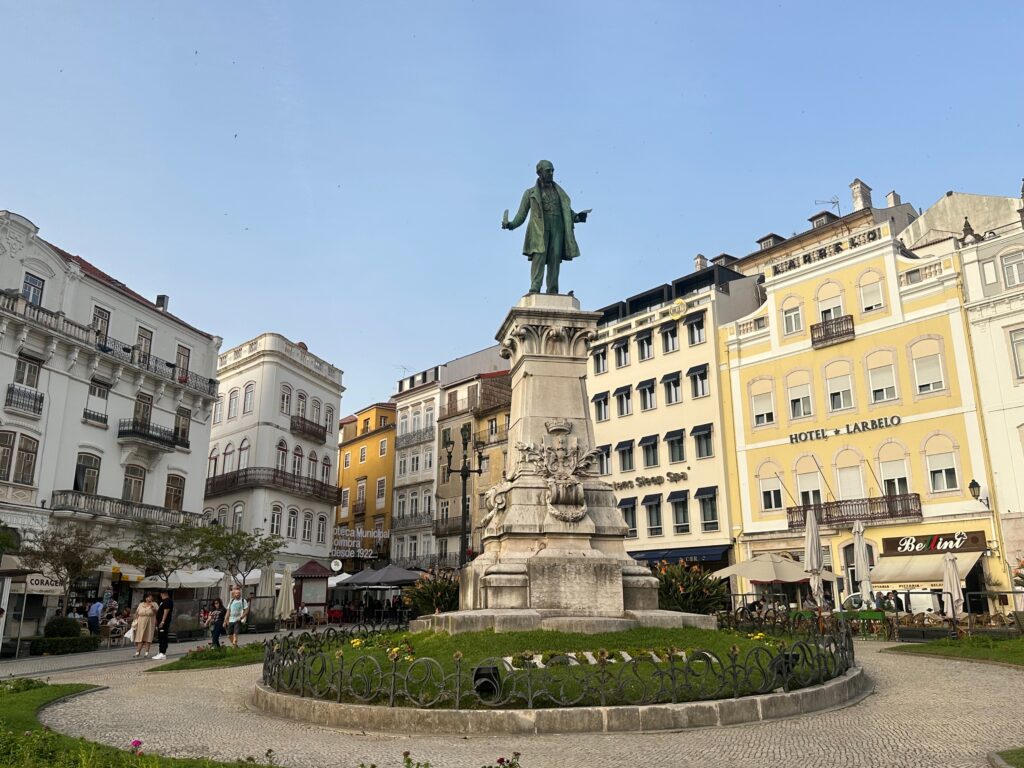
Coimbra
Suggested highlights of Coimbra:
- Walk through the medieval old town.
- Coimbra University – one of the oldest in Europe, founded in 1290. It is listed as a World Heritage Site.
- Joanine Library – one of the world’s finest libraries.
- Great Hall of Acts – was the throne room when the building was the Royal Palace.
- Santa Cruz Monastery founded in 1131, beautiful blue tiles.
- Monastery of Santa Clara
- St Bartolomeu Church for the gilded woodcarving altarpieces, dates back to 10th Century.
- St Tiago Church – built at the end of the 12th Century.
- Listen to Fado music at Fado ao Centro.
- Paco de Sobre Ripas (Sub-ripas House) – defensive tower of the city wall adapted to a residence.
- Old Cathedral – built in the 12th Century
DRIVE COIMBRA TO OBIDOS, PORTUGAL
On the drive between Coimbra and Obidos we can recommend a few beautiful places to stop and see:
- Tomar – beautiful small town where we encountered an Easter Sunday procession. Worthwhile stopping to see the square, Church of St John the Baptist, view of fort, pedestrian shopping street. Convent of Christ (Convento de Cristo) – UNESCO World Heritage Site.
- Aquaduct of Pegoes – just outside of Tomar. Built between 1593-1614 to supply water to the Convent of Christ in Tomar. It is about 6km long, 30m high and is a national monument.
- Monastery of Batalha – huge Gothic monastery built 1386-1517 – seeing is believing! One of the most visited monuments in Portugal.
- Sitios and Nazare – stopped to see the famous ‘big’ surfing waves of Nazare. Unfortunately for us not so big today. Beautiful views from Sitios.
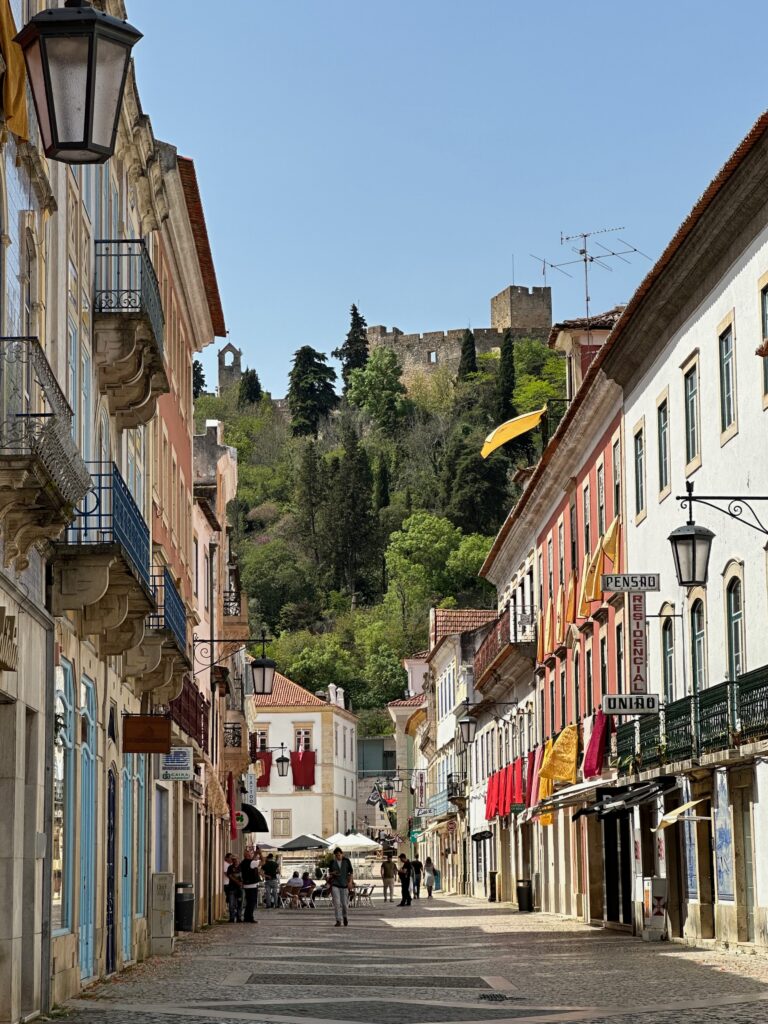
Tomar
OBIDOS, PORTUGAL
Accommodation: Aquae Ductus Suites, Obidos – modern, clean room about 800m walk from the entrance to old town Obidos.
Obidos is one of the best preserved medieval towns in Portugal – with castle walls still intact. The town and its castle were declared a National Monument in 1951. It has been voted as one of the seven wonders of Portugal and well worth a visit.

Obidos
You will find very photogenic streets – lovely to wander and shop for good quality gifts.
Suggested highlights:
- Town Gate (Porta de Vila) – the beautiful entrance gate to Obidos
- Castle of Obidos
- It is possible to walk the walls of the town but there are no guard rails!
- Wander the streets of Obidos – many good restaurants and beautiful gift shops.
- Church of St Mary (Igreja de Santa Maria) – main church of Obidos, famous for the carved stone tomb of Joao de Noronha (a national monument), painted wooden ceiling, beautiful tiles from the 1600s line the walls.
- Church of Mercy (Igreja da Santa Case da Misericordia) – hand-painted blue and yellow tiles from the 1600’s.
We had a delicious dinner at Restaurante Alcaide on the main street of Obidos – highly recommended.
There is an open carpark just outside Obidos city walls with paid parking – so access is easy if it’s not in peak season.
LISBON, PORTUGAL
Accommodation: Hotel de Britania Art Deco – Lisbon Heritage Collection – highly recommended. Beautiful rooms, delicious breakfast, wonderful staff, parking available. Inexpensive and healthy restaurant nearby – Honest Greens.
Lisbon is a beautiful city and you will need a few days to see the main sights and wander. It is a very hilly city and there are some strenuous walks. The trams are charming and a good way to get around.
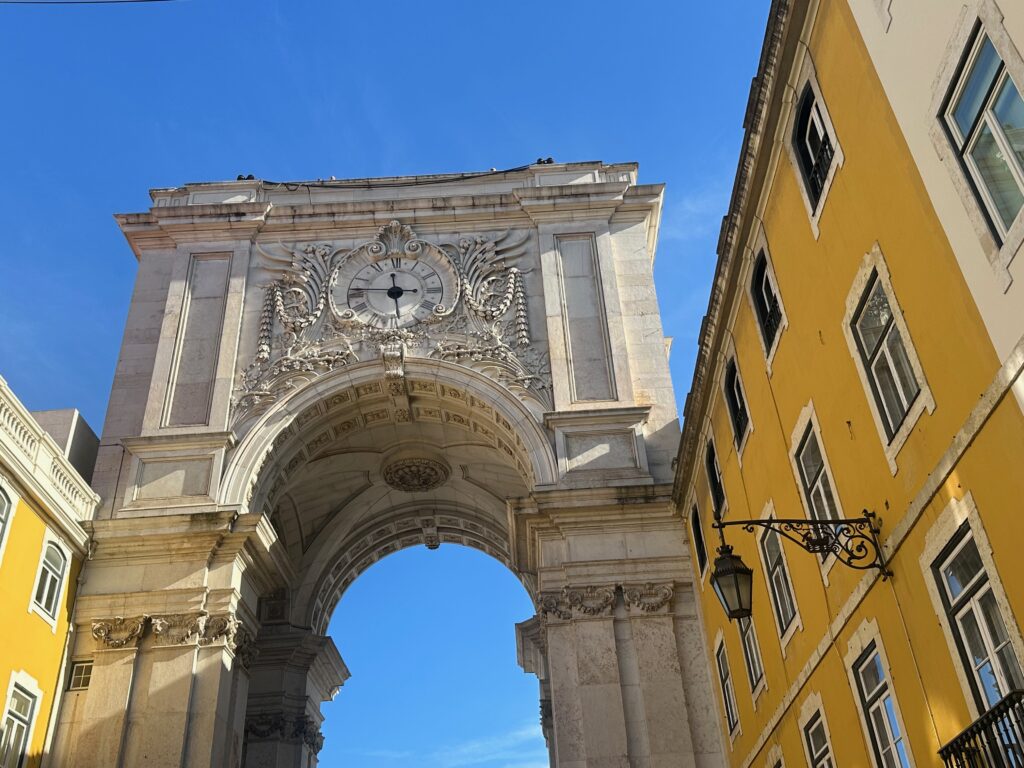
Rua Augusta Arch
To orientate ourselves we did a walking tour which gave a history of Portugal and a walk through the various neighbourhoods of the city – Barro Alto, Chiado, Baixa, Alfama. We also did two hop-on-hop-off bus tours.
Recommendations:
- Lisbon Chill Out Walking Tour – fabulous introduction to the city.
- Yellow Hop On Hop Off Bus Tour – Belem & Lisbon Tour. Belem is an area of museums and monuments.
- Yellow Bus Hop on Hop Off Tour – Modern Lisbon Tour including Park of Nations.
- Barro Alto (upper town) – nightlife district – bars, clubs, restaurants, fado. We can recommend O Faia, (Fado House since 1947) for meal and fado performances – R. da Barroca 54 56, 1200-050 Lisboa.
- Chiado – upmarket district – elegant shops (Rua Garrett), bookstores, cafes, Carmo Convent ruins and museum, National Museum of Contemporary Art, Luís de Camões Square, Carmo Terraces (for beautiful views), Bertrand Bookstore (world’s oldest bookstore), Church of Our Lady of the Incarnation, Basilica of Our Lady of the Martyrs, Church of Our Lady of the Loreto.
- Baixa – (lower town) – rebuilt after the 1755 earthquake, this is Lisbon’s downtown – shopping, restaurants, grand buildings and squares. Here you will find magnificent Praça do Comércio (Lisbon’s largest square) facing the river, Rua Augusta (the city’s main pedestrian street), Rua Augusta Arch (excellent view from the top), Rossio Square (the main/central square of Lisbon), Santa Justa Elevator linking Baixa with Chiado (lovely views from balcony on top of elevator), the Design and Fashion Museum (MuDe), many beautiful churches.
- Alfama – (Moorish quarter) – the oldest neighbourhood in Lisbon, a maze of narrow streets, very interesting area to wander. There are several sights here including Lisbon Cathedral, Castelo de Sao Jorge (St George’s Castle), Palacio Azurara (Decorative Arts Museum housed in a former aristocrat’s home), Portas do Sol Viewpoint, Monastery of São Vicente de Fora (St. Vincent Outside the Walls) for views and beautiful tiles (azulejos), Fado Museum, Campo das Cebolas square (here is Casa dos Bicos – museum dedicated to Nobel Prize author José Saramago).
- Ride Tram 28 – Lisbon’s most famous tram – through Alfama and Baixa.
- Belem – cultural district – museums and monuments including UNESCO World Heritage Belem Tower and Jeronimos Monastery (Vasco da Gama’s burial place); Belem Palace (official residence of Portugal’s president), Centro Cultural de Belem art gallery, world-famous custard tarts from Pastéis de Belém.
- Modern Lisbon – Vasco da Garma Tower, Oceanarium, modern architecture – a good way to see this area of Lisbon is on a Yellow Bus Hop on Hop Off Tour (which also takes in the Park of Nations).
- Park of Nations – riverside district in modern Lisbon.
- Tile Museum – traces the origins and evolution of tile art, a wonderful collection of tile art, housed in a beautiful 16th century convent building.
- Lisbon is built on several hills and has many viewpoints or miradouros. We loved the view from Miradouro Sophia de Mello Breyneer Andresen, but there are many more – see Lisbon Portugal Tourism Viewpoints for more details.
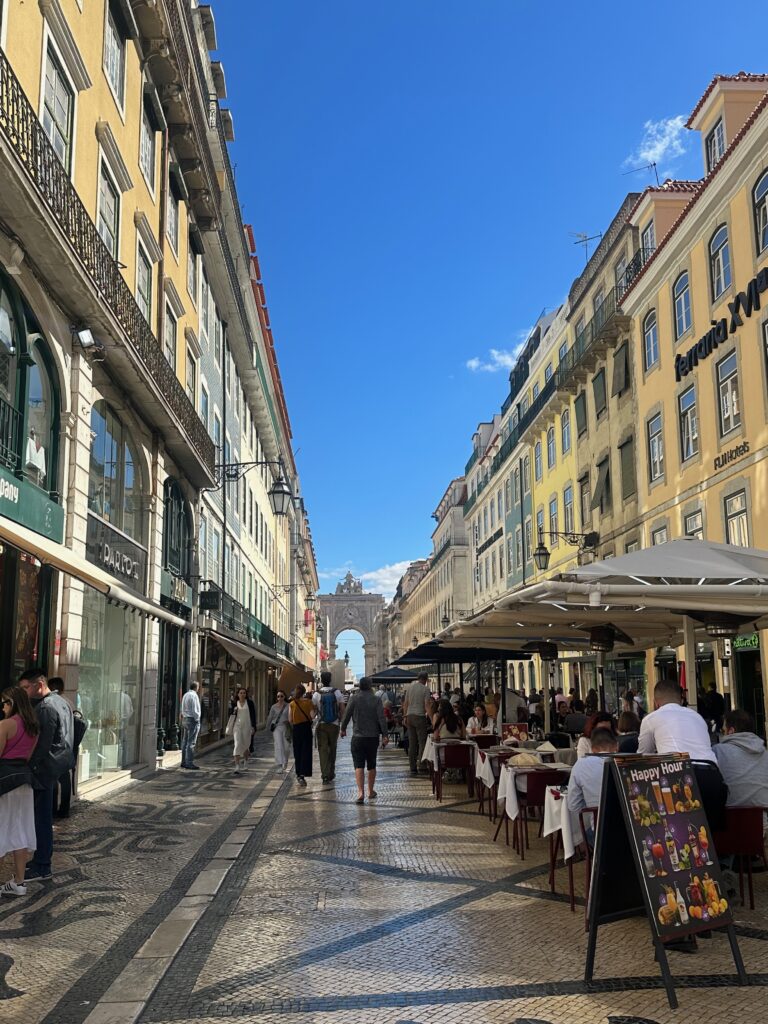
Augusta Street, Lisbon
An excellent website for information on what to see and do in Lisbon is the Lisbon Portugal Tourism website.
SINTRA, PORTUGAL
Beautiful Sintra is a UNESCO World Heritage Site and can be visited as a day trip from Lisbon – just a 30 minute drive. There is much to see and it is advisable to set off early to spend the full day in Sintra, or if time, spend a night or two.
Parking can be a problem – we found space in the Rio do Porto carpark for Euro 4.70 (it is a steep walk up to the town). To avoid a long, steep walk we hired a tuk tuk and driver (30 Euros per person) from the carpark to take us on a tour of the sights.

Sintra
The sights of Sintra are spread out. Some people walk but it is a long uphill walk to the main sights so hiring a tuk tuk was a good option. Once in Sintra Old Town, walking is easy.
Suggested highlights:
- Fonte da Sabuga – Fountain dating back to 1757 where people fill their water bottles as water is naturally filtered and has healthy minerals.
- Pena Palace – best to book ticket ahead of time if want to go inside as it is so popular.
- We see the ruins of Castelo dos Mouros (Castle of the Moors) high above us.
- Quinta da Regaleira
- Royal Palace – a highlight.
- Sintra Old Town
- Delicious Pastel de Nata (custard tarts) freshly baked.
- Try Ginja, a delicious Portuguese cherry liquor – served in little chocolate cups.
- Monsarrate Palace – a highlight. It is about a 20 minute drive from Sintra and once there it is a 12-minute walk to the house from the carpark.
We recommend a scenic drive back to Lisbon on the coastal route:
Sintra -> Cabo Da Roca -> Guicho -> Cascais -> Estoril -> Carcavelos -> Belem -> Lisbon

Cascais
We stopped at Cabo da Roca (the westernmost point of northern Europe). We bought delicious pastries from the café and there are rest rooms too (a little hard to come by). We had to buy something to use the bathroom!
EVORA, PORTUGAL
Accommodation: Madre de Deus, 5 – Terrace, Evora – a charming 2-storey house in walking distance to all the highlights.
Founded by the Romans, Evora is the capital of the Alentejo and a UNESCO World Heritage city. In the 16th Century the city was home to Portuguese kings. Evora’s historical centre is charming and easily walkable.

Temple of Diana, Evora
Suggested highlights:
- Giraldo Square
- Sao Francisco Church and Chapel of the Bones
- Church of Sao Joao Evangelista
- Roman Temple of Diana
- Evora Cathedral
- Evora Museum
- University of Evora
VILA NOVA DE MILFONTES & WEST COAST OF PORTUGAL
Accommodation: Raminhos Guest House,Vila Nova de Milfontes – a charming guest house in walking distance to centre of town. The host is most helpful in recommending what to see and do and where to eat.
From Evora to Vila Nova de Milfontes is just over a two-hour drive.
Vila Nova de Milfontes is a lovely town on the coast with lots of good restaurants and pretty coastal surrounds – there are beautiful beaches nearby.

Vila Nova de Milfontes
Eateries:
- Mabi – Gelataria Cafeteria
- Pao Cafe
- Porto das Barcas
- Patio Alentejano
- Ritual Restaurante Tapas Bar
- Adega 22 Restaurante
- O Pescador
- Restaurant a Fateixa
- Manjedoura
- Alento Restaurante
DRIVE FROM VILA NOVA DE MILFONTES TO SAGRES
From Vila Nova de Milfontes it is a very beautiful drive along the coastline, with many beautiful beaches along the way:
- Almograve Beach
- Zambujeira do Mar – lovely coastal town with beautiful beach, dramatic cliffs.
- Odeceixe Beach – some lovely looking places to eat overlooking beach.
- Aljezur area – Arrifana Beach – fabulous beach/views, Arrifana Fortress with good restaurant (O Paulo Restaurante).
- Bordeira Beach plus a short boardwalk to the ruins of Islamic Fishermen Village – fabulous views.
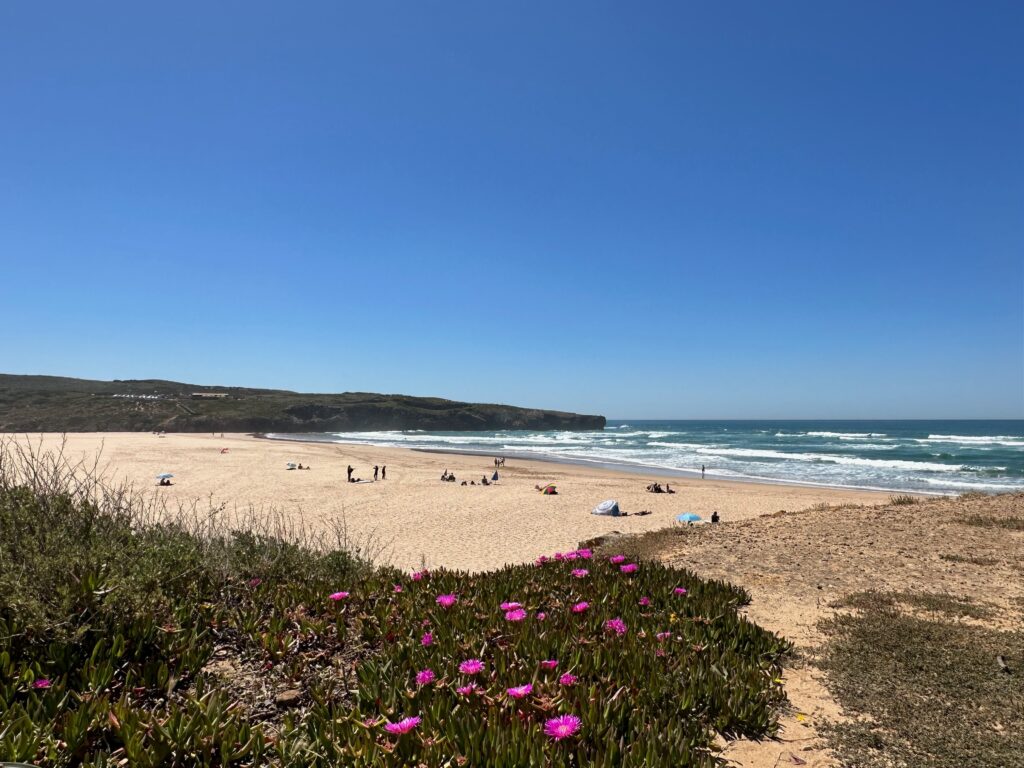
Aljezur, Costa Vicentina
A lot of these beaches are in a beautiful area called Southwest Alentejo and Vicentine Coast Natural Park.
SAGRES, PORTUGAL
Accommodation: Sagres Time Apartamentos, Sagres – highly recommended.
We found Sagres a relatively quiet, unspoiled place on the Algarve coast with some good restaurants (Salema Restaurant in particular). The most famous landmarks at Sagres are the Fort and Cape St Vincent – the most south-westerly point in Portugal.

Sagres
ALGARVE COAST BETWEEN LAGOS & TAVIRA, PORTUGAL
Accommodation: Hotel Rural Quinta do Marco, Tavira – in a rural setting near Tavira – highly recommended. Attractive renovated rooms, lovely views, delicious dinner at restaurant (book before arrival).
We suggest an early start to drive the Algarve Coast to give time for a few walks to see rock formations. Even better, take a few days to explore the coastline and towns.

Ponta da Piedade, Algarve
Recommendations:
- Lagos Tourist Information Office for map and advice on what to see.
- Ponta da Piedade headland – Walk the boardwalk to see beautiful rock formations and lovely views of the coast.
- Alvor
- Portimao
- Ferragudo – drive around headland, attractive village
- Carvoeiro Boardwalk – Park near Algar Seco Parque Residential and take the beautiful walk along the boardwalk beside cliffs (1.2 mile round walk). Walk down to Boneca Bar – lovely shapes in rocks through narrow passageway. Continue walking past the little fortress and chapel to see lovely views of Cavoeiro Beach and town.
- Praia de Marinha – park in carpark and walk along cliffs – lovely views, arches in rocks.
- Albufeira – one of the most touristed towns in the Algarve.
- Tavira – Very lovely town – highly recommend a visit. Park and walk through little streets by the river, cross river over to main square, walk to Mercado Ribeira through gardens, castle gardens, church exterior, back through main square, over bridge to square. Visit the Church of Misericordia (one of the most beautiful in the Algarve, blue and white azulejo tiles). Tavira Beach can be reached by ferry.

Carvoeiro, Algarve
SEVILLE, SPAIN
Accommodation: Hotel Giralda Center – four star hotel, spacious rooms, highly recommended. We found it difficult to book accommodation in Seville during our visit as it was the weekend of an international football match plus a bull fighting festival – so we stayed at the Hotel Giralda Center – a more expensive hotel than where we would normally stay due to limited availability elsewhere.
Seville is a vibrant city – one of our favourites for its culture, history and architecture.

Santa Cruz neighbourhood, Seville
Recommendations:
- White Umbrella Tours – Free Walking Tour of Seville
- Plaza de Espana – built in 1929 for the Spanish Americas Fair. It is an impressive and beautiful building. Each province is represented with scenes depicted in tiles, a bench and a map. There were 80 pavilions built for the fair but only 40 remain.
- Park Maria Luisa (Parque de María Luisa)
- Royal Tobacco Factory of Seville (Antigua Fabrica de Tabacos) now a university building.
- Alfonso XIII Hotel – many famous people have stayed there including Barack Obama.
- Torre del Oro (gold tower) – built in 1221, originally covered in gold and was part of the city wall.
- Bullfighting Ring (Plaza de Toros) – still hold bullfights there.
- Vinuesa Street – restaurants and bars.
- Royal Alcazar of Seville – royal palace complex – a highlight. The Site was originally a fort but was added to over 11 centuries. Most impressive addition was in 14th century – Palacio de Do Pedro (also known as Palacio Mudejar). The Alcazar is still a royal palace – the apartments can be visited. It is advisable to book tickets in advance as it is so popular.
- Seville Cathedral (Catedral de Santa Maria de la Sede) – world’s largest Gothic cathedral.
- La Giralda (bell tower) – ramps inside – when it was a mosque people could ride donkeys up the ramps to top to pray. Weather vane at top was added in 18th century. All the bells in the tower have a name.
- Jewish Quarter – Santa Cruz
- Casa de Pilatos – 16th Century palace
- Museum of Fine Arts (Museo de Bellas Artes) – second only in importance to Madrid’s Prado.
- Flamenco Museum & Shows – see and learn about flamenco dancing.

Plaza de Espana, Seville
RONDA, SPAIN
Accommodation: Apartamentos Martalia Arenal – brand new, modern apartments, self-check in. Although quite a way from centre of Ronda we can highly recommend. We drove into the centre and parked in underground carpark of Plaza del Socorro – right in the heart of Ronda.
Ronda is a very pretty town with amazing views and well worth a visit. Puento Nuevo bridge is a highlight. The main shopping street is busy during the evening with shoppers – it is modern, attractive and has a great atmosphere. Plaza del Socorro and Nuestra Senora del Socorro Church – very pretty.

Puento Nuevo bridge, Ronda
GRANADA, SPAIN
Accommodation: B&B Hotel Granada Estacion (next door to bus station), very comfortable room. Booked a parking space at the hotel for 15 Euros/day.
Granada is a vibrant, beautiful city – one of our favourite on the trip. The highlight here is the Ahlambra, a UNESCO World Heritage site and one of the most visited sights in Spain.
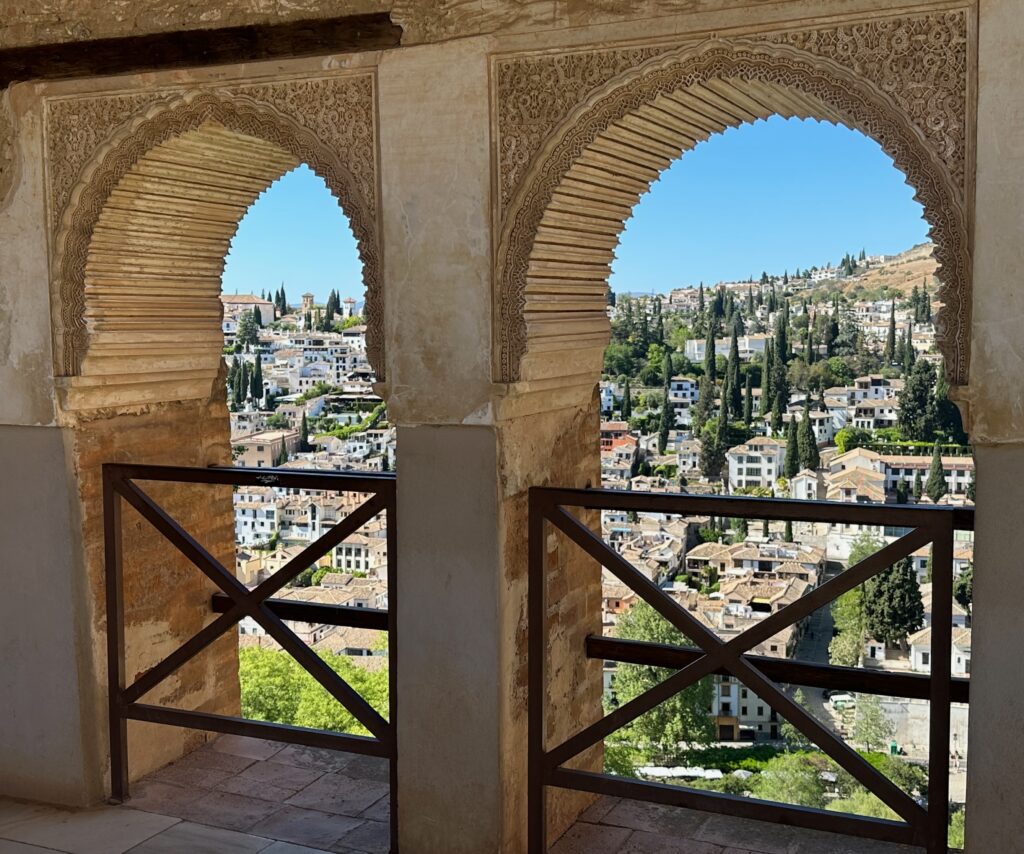
Granada, from the Alhambra
As an introduction to the city we took the 11am Free City Walk – wonderful, highly recommended. Most of the tour was spent in lower old town. We visit:
- Isabella Square
- La Carrera del Darro – the lovely street alongside the left bank of the Darro River (from Plaza Nueva to Casa de las Chirimias). We were lucky to experience the “We Love Granada Market” along this street – good quality gifts.
- Corral del Carbon (House of Corn) building – dating back to 14th century from Muslim period, was used as a warehouse and hotel for merchants.
- Alcaiceria – narrow streets of old souk district of Granada.
- Bib Rambla Square – an historic square where many important events in Granada’s history have taken place – market place, university, bullfights, trials, executions, Christmas markets.
- Granada Cathedral – one of the biggest in Spain, built between 1526-1704, small fee to enter, audio tour available.
- Capilla Real (Royal Chapel) – tombs of Queen Isabella I and King Ferdinand .
- The Madraza – founded in 1349 as a university, then became the Town Hall, now part of the Granada University.
- San Gil Street, a charming street of tea houses.
- Church of St Gregory
- Los Carvajales viewpoint in the oldest neighbourhood of Granada (the Albaicin) – good views of the Alhambra.
Flamenco is special in Granada as visitors can see Flamenco dancing in a cave, where it originated – Zambra Maria la Canastera.

Royal Palace, Alhambra
A highlight of Granada is the Ahlambra
Can reach three ways:
- Walk
- Bus (1.40 Euros)
- Taxi (6.41 Euros)
We took a taxi and asked to be dropped at the Door of Justice, which is close to the Alcazaba.
The Ahlambra is an historic complex above Granada and the most popular sights are the Alcazaba (fort), the Royal Palace and the Generalife.
It is highly recommended to book your Ahlambra ticket online well in advance of your visit.
Recommended way to see the Ahlambra is:
- Visit Alcazaba first – the fortress. The Alcazaba is mostly ruins and has fabulous views of Granada.
- Visit Royal Palace (Nasrid Palace) – the most popular section of the Ahlambra.
- Visit the Generalife – a summer palace and gardens.
Visiting Alcazaba
Visitors must show proof of ID (we used our passport) to enter. The Alcazaba has a lot of steps! After entry, there is a circuit – walking up steps to various towers with lovely views across Granada.
Visiting Royal Palace
Visits to the Royal Palace should be booked in advance – the booking gives you a time of entry. There is a circuit here too – walk through what used to be the public areas and then what used to be the private residences. It is a very beautiful palace.
Visiting Generalife
From the Royal Palace it is a lovely walk across to the Generalife (you do not have to show passport again). It looks a long way to walk but there are shady spots to sit and rest. It is well worth a visit.
From the Generalife we exited the Alhambra complex – there is a lovely shady place – La Mimbre Restaurante – to sit and have a drink. From there we took the beautiful pedestrianised Cuesta Del Rey Chico pathway down to Carrera de Darro – the beautiful street next to the ‘river’.
Food recommendations:
Bodega Castenada, El Molino (Jewish Quarter), Om Kalsum (Moroccan tapas).
Best Ice Cream – La Veneciana Los Italianos.
CORDOBA, SPAIN
Accommodation: La Cupula apartment/studios – Calle Diario de Córdoba 5, 14002 Córdoba – we had a Family Studio, small but very nice, good location, can walk to centre of town. Secure parking nearby (host guides you there).
To orientate ourselves we did a Free Walking Tour of Cordoba at 7pm meeting our guide in Plaza del Triunfo – highly recommended. It was an ideal time of day to take this tour as it is cool (it was 35 degrees Celsius during the day) and the light is very good for taking photos.
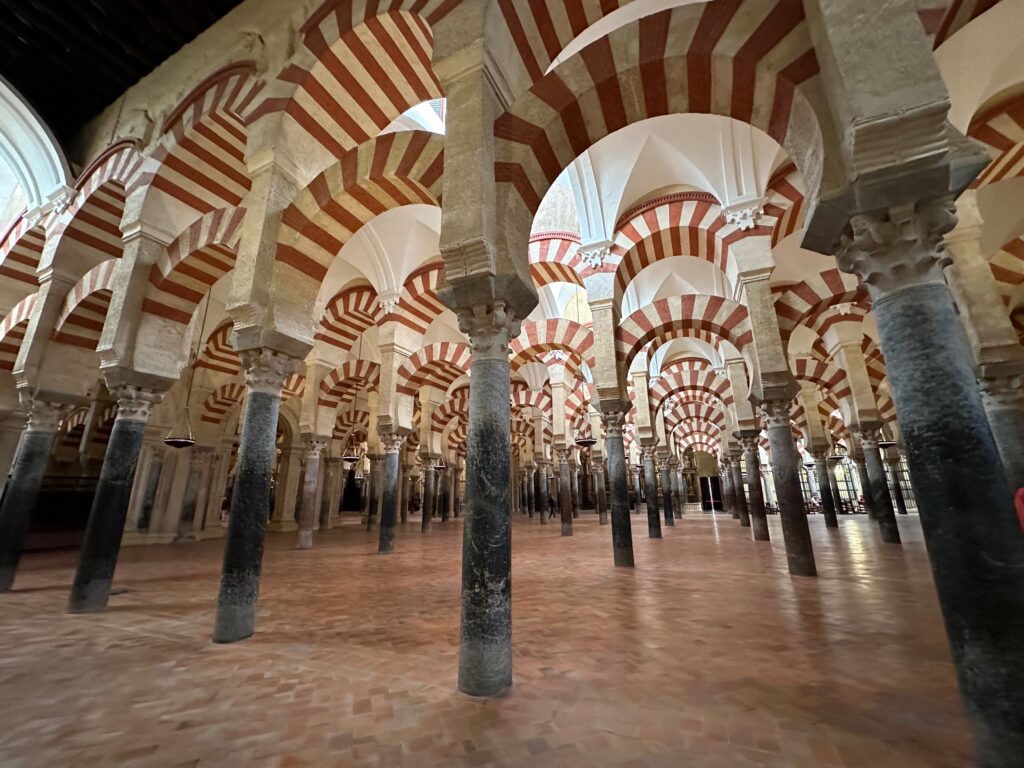
Mosque-Cathedral of Cordoba
Recommended sites in beautiful Cordoba:
- Great Mosque of Cordoba – a highlight
- Alcazar de los Reyes Cristianos (Alcazar of the Christian Monarchs) – lovely garden
- View of Mosque through Calleja de las Flores (Alley of Flowers)
- Plaza del Triunfo – enter the square through the Gate of the Bridge (or Arc de Triumph). Walk on the Roman Bridge opposite. Good views looking back at the city.
- See the Patios – flower-filled squares in homes – pay to go in.
MADRID, SPAIN
Accommodation: B&B Hotel Fuenlabrada – chosen on price, parking available and whilst quite far from the centre of Madrid (about 15kms) it is a good location when we drive out on day trips.
Madrid is the capital of Spain. The city was originally built by the Arabs who were expelled by the Hapsburgs in the 1500s. There is much to see!
We took the metro (Parque de los Estados Metro Station is about a 5 minute walk from hotel) into the city (Sol Plaza) for an 11am Walking Tour – excellent walking tour with a great guide – highly recommended as a starting point when visiting Madrid.
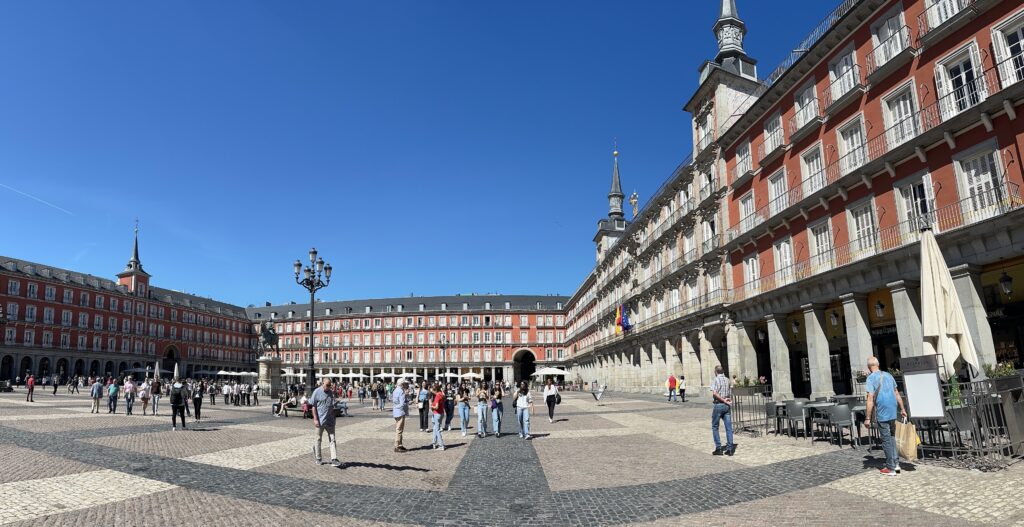
Plaza Mayor, Madrid
Suggested highlights of Madrid:
- Gran Via – a grand boulevard lined with Belle-epoque facades, shops, hotels, restaurants.
- Prado Museum – one of the world’s most famous art galleries
- Puerta del Sol (the Gate of the Sun) – popular square where people gather on NYE to see the golden ball drop and the clock in the square strikes 12 midnight. There is a tradition that people eat 12 grapes – 12 grapes in 12 seconds, one for each time the clock strikes – brings good luck.
- Plaza Santa Ana – charming square in Madrid’s Literary Quarter (Barrio de las Letras neighbourhood, also known as Huertas) – local boutiques, restaurants, bars.
- Retiro Park – UNESCO World Heritage site – 125 acres of park, gardens, pavilions, artificial lake.
- Try Iberian Ham at Caprichio Diaro in Calle de Postas
- Plaza Mayor – beautiful square built by the Hapsburgs in the 1400s
- See Flamenco dancing at La Quimera, just off Plaza Mayor
- Try tapas – in Calle de la Cava Baja – one of the best streets for tapas in Madrid.
- Casa Botin – the oldest restaurant in the world – speciality is suckling pig.
- Monastery of Corpus Christi las Carboneras on Calle del Codo – a convent of eight nuns – selling biscuits – people are not allowed to see the nuns so there is a ‘lazy Susan’ set up – you place money on and they place biscuits on!
- Plaza de la Villa – see the former Town Hall and the Casa de los Lunanes – built in the 1400s.
- Church of Saint Nicholas (San Nicolas de los Servitas) – originally built as a mosque in the 1200s, tower used to be a minuret.
- Royal Palace – the largest palace in Europe it is the official residence of the Spanish Royal Family. It was built where the Alcazar (castle) used to be.
TOLEDO, SPAIN
Toledo is the former capital of Spain and a UNESCO World Heritage Site.
We drove to Toledo from Madrid as a day trip. It is very difficult to find parking so advisable to get there early morning.
We took a Free Walking Tour at 12 noon (1.5 hours) – recommended as there is so much history in Toledo.
Toledo is very popular with tourists so expect crowds.

Toledo
SEGOVIA, SPAIN
We drove to Segovia from Madrid as a day trip from Madrid. We drove via the freeway – just over a one hour drive.
Segovia is famous for its Roman Aqueduct – it’s a beautiful place.
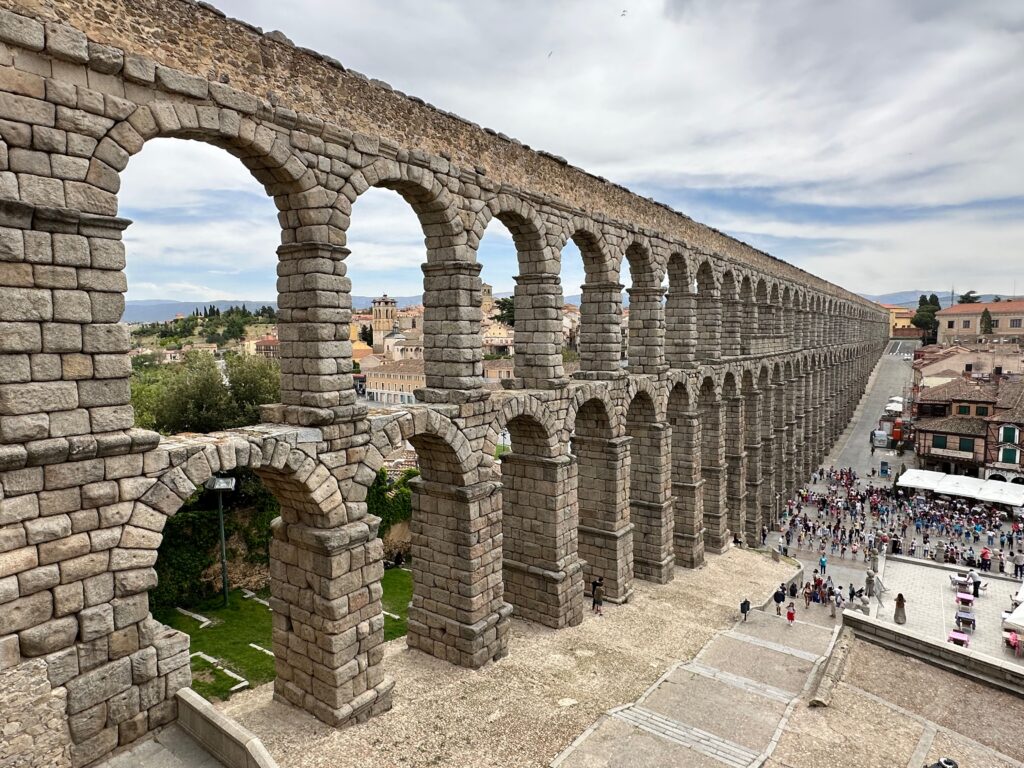
Segovia Aqueduct
We found timed parking on a street near the aqueduct and walked to the Tourist Information Office at Pl. Azoguejo (right near aqueduct) where we picked up a map.
The suggested way to see the beautiful old town of Segovia is as follows:
- To access the old town, walk up steps near the Tourist Information Office. There is a great view back to the aqueduct from the top of the steps.
- Walk along Calle Cervantes (Royal Street) to the Canaleja – Viewpoint near the House of Peaks.
- Walk along Calle de Juan Bravo (one of the main streets in the old town) – lovely shops and buildings, including the church of San Martin and the Royal Prison.
- Paseo del Salon – lovely views of the green space around Segovia.
- Continue on to Plaza Mayor and the Cathedral
- At this point we had a delicious lunch at Pasapan restaurant – highly recommended.
- After lunch we walked to the Alcazar (fortress) stopping at the viewpoint in Plaza Jardin Mauricio Fromkes from which can be seen St Mary of Parral’s Monastery and surrounding countryside. If time permits, after visiting the Alcazar, a good thing to do would be to walk back on the pathway down by the river Eresma and back up to Paseo de Santo Domingo de Guzman – this takes about an hour.

Alcazar, Segovia
The above is a basic itinerary for Segovia – there are so many historic churches and historic buildings to see. The map from the Tourist Information Office lists them all and is a wonderful guide.
ROYAL MONASTERY SAN LORENZO DE EL ESCORIAL
On the drive back to Madrid we stopped to see the Royal Monastery San Lorenzo de El Escorial – a UNESCO World Heritage Site. We under-estimated the time needed to see this and would recommend it as a separate day trip from Madrid. For details see the Spanish Tourism website.

Monastery San Lorenzo de El Escorial
MONTPELLIER, FRANCE
Accommodation: B&B Montpellier Sud Lattes – Lovely host, very helpful and friendly. This is a two-star hotel and very well priced. We have room 214 on the first floor. The room and bathroom are small but clean. There is an open carpark that is fenced and locked at night. It is about a 15-minute drive from the city centre (Place de la Comedie). There is a shopping centre that includes a supermarket 4 minutes drive from the hotel.
We drive into Montpellier centre (about 6 kms) to do a Free Walking Tour, parking under the Place de la Comedie – right in the heart of Montpellier.

Place de la Comédie, Montpellier
We meet our tour guide in front of the fountain in Place de la Comedie, nicknamed ‘egg square’ because of its shape.
Our guide takes us through the medieval city and we hear about the history of the city and local anecdotes, we visit different neighbourhoods and learn about the people who shaped the city through the centuries.
We hear about Saint Roch, who was born in Montpellier and is the patron saint of the city.
We visit the old post office neighbourhood, wander pretty medieval streets lined with local boutiques and colourful bunting, hear stories of the early study of medicine in the city, we see street art, visit the neighbourhood of St Anne, buy delicious baked treats from the Des Reves & du Pain Bakery, and visit the old Jewish neighbourhood where the tour ends.
There are lots of lovely outdoor cafes full of people having coffee, meeting for lunch – it is a wonderful atmosphere – lively and vibrant.
The Free Walking Tour is a great way to explore the city and highly recommended.

Mural in Place Saint-Roch, Montpellier
After the walking tour, we visit the neighbourhood of Meditarranee – known for its colourful street art especially in Rue de la Mediterranee and Rue de Lorraine. We also visit the neighbourhood of Antigone – known for its architecture by Ricardo Bofill.
Later in the day we take a drive to Sete and drive through the pretty town – lovely canal down the centre, lined with beautiful buildings. Huge marina and a long beach along the causeway.
We loved Montpellier and can highly recommend a visit – we wish we had spent longer.
For more information, visit the Montpellier Tourism website.
AIX EN PROVENCE, FRANCE
We visit Aix en Provence for a few hours on the way to Sainte Maximes on the French coast.
Aix en Provence is a beautiful city and well worth a few days at least.
Parking is available in an underground parking station – Parking Rotonde Monoprix – near the main square (Square du Colonel Antoinne Mattei). The Tourist Information Office is on the square and we pick up a city map + brochure/map on the Cezanne Walk (Cezanne was born in Aix en Provence) + brochure/map on the Fountains Walk – the city is known as the city of 1000 fountains. Can highly recommend both these walks.

Hotel de Caumont – Art Centre
For lunch we had a delicious meal at charming De L’une a L’autre. It is about a 15 minute walk from the Tourist Office. Highly recommended.
SAINTE MAXIME, FRANCE
Accommodation: B&B Hotel Sainte-Maxime Golfe de Saint Tropez
Our accommodation is near the town of Sainte Maxime, about 30 minutes drive from St Tropez. The B&B Hotel is only about 3 years old so all is new and clean. We have Room 213 on 2nd floor (lift access). The hotel is located a newly built area – a strip of buildings that has supermarket and then offices and semi-industrial type shops. There are plenty of parking spaces in front of the hotel (free parking).

Sainte-Maxime market
Sainte Maxime is a lovely, unspoilt town and worth a longer stay.
We visit the Sainte Maxime Tourist Office to pick up a map of the Riviera coastline – which we will be driving.
We then take a stroll through the old town streets. There is a food market in the old town today and the sights and aromas of the cheese and other fresh produce is wonderful.
It is a beautiful town and like most towns along the Riviera coast, has a pretty harbour filled with yachts.
SAINT TROPEZ, FRANCE
From Sainte Maxime, we make a brief visit to beautiful Saint Tropez one evening.
Firstly we head for Pampelonne Beach to have a picnic on the lovely long sandy beach. There is plenty of parking behind the beach – no one there and we have the beach to ourselves. It is a beautiful evening.
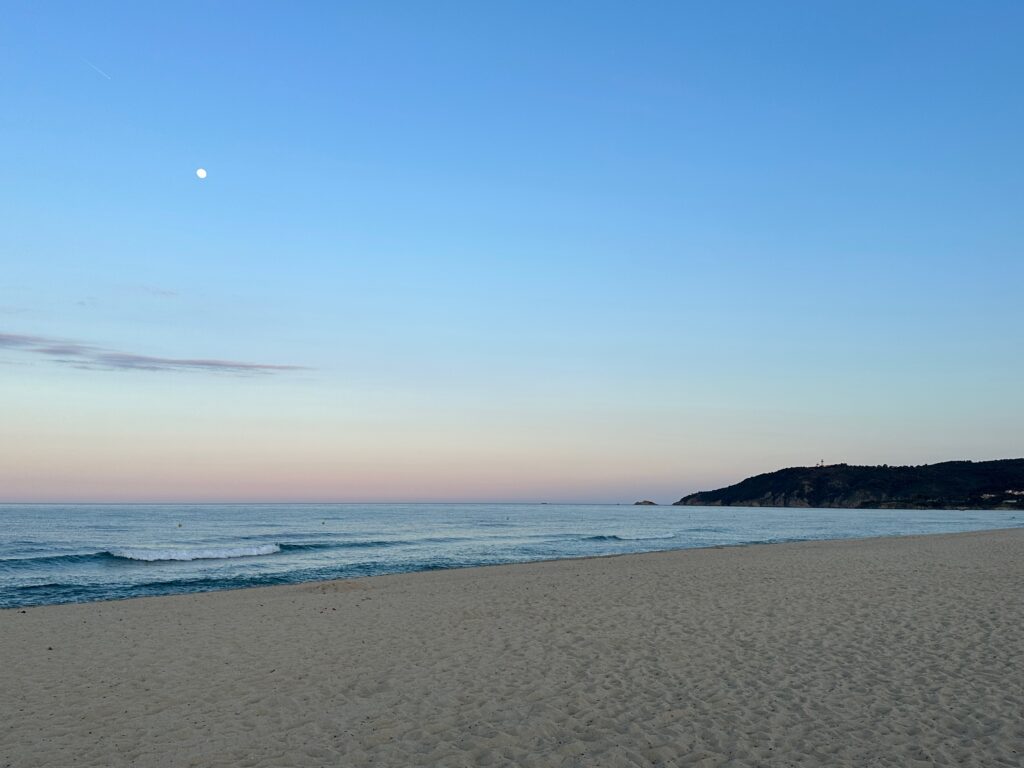
Plage de la Pampelonne, St Tropez
Driving into St Tropez we park at the Port – there is a large open carpark there – paid parking. It is next to the waterfront promenade and the shops.
We stroll through the old town looking at the lovely boutiques – it is very upmarket. We buy a delicious ice cream at Barbarac and stroll along the waterfront looking at the mega yachts. The cafes are filled with people enjoying dinner. We walk up onto the little ‘fort’ for a lovely night time view over the bay.
St Tropez is gorgeous and well worth a visit.
DRIVE ALONG THE RIVIERA COAST FROM SAINTE MAXIME TO MONACO
From Sainte Maxime – Drive along the Riviera: Saint Raphael – Corniche de L’Esterel – Cannes – Antibes – Cagnes-sur-Mer – Nice – Villefranche-sur-Mer – Monaco
We have visited the French Riviera some years ago, so on the drive along the coast (making our way up to Switzerland) we did not spend time in each of the fabulous towns and villages along the way (except for St Paul de Vence) and broke the trip in B&B Hotels near Sainte Maxime and in Villeneuve Loubet Village (between Nice and Antibes). The French Riviera is a trip on its own!
From Sainte Maxime the road pretty much follows the coast the whole way.

Saint-Raphael, Cote de l’Esterel
The Corniche de L’Esterel between St Raphael and Theoule-sur-Mer is beautiful with its red rock mountains of the Esterel mountain range and red rocky bays.
Antibes is particularly attractive – especially the old town – but very crowded on the day we drive through.
There is a cycle way along the coast – and we see that the coastal promenade has been upgraded as we get closer to Nice.
A highlight of the trip is between Nice and Monaco. There are three roads to choose from: the Basse Corniche (coast road), the Moyenne Corniche (middle road) or the Grande Corniche (top road). Our favourite is the Grande Corniche – spectacular views!
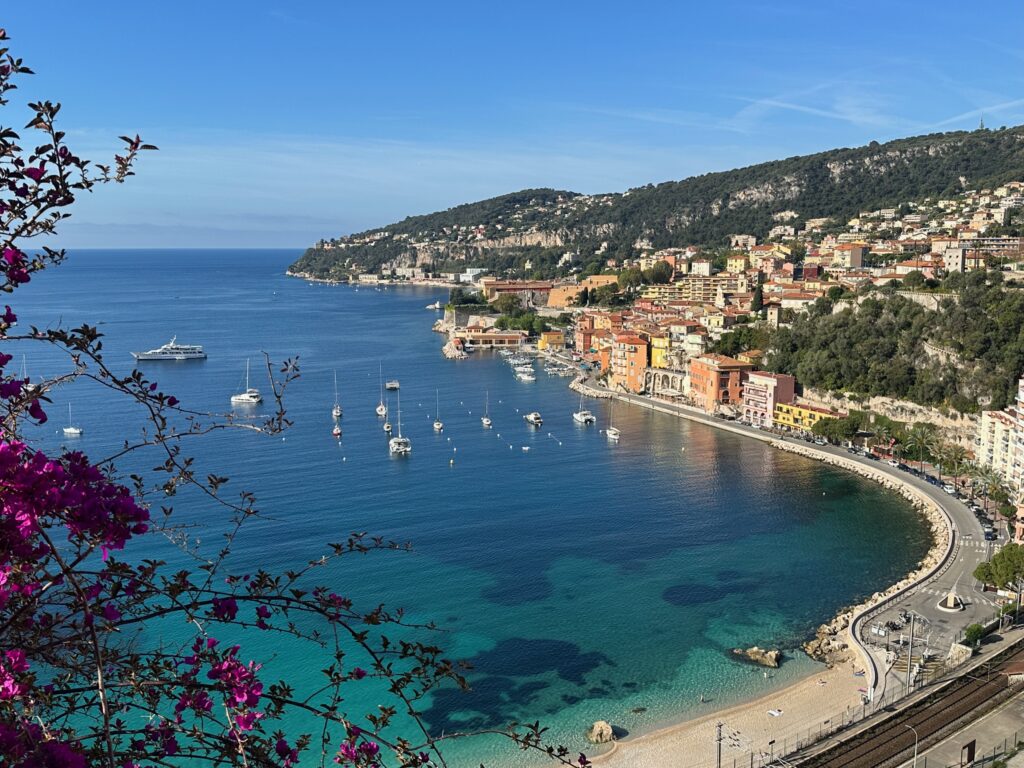
Villefranche-sur-Mer, Cote de la Riviera
VILLENEUVE LOUBET VILLAGE, FRANCE
Accommodation:B&B Hotel Villeneuve Loubet Village – we stay two nights at B&B Hotel Villeneuve Loubet Village, between Antibes and Nice as we want to visit the hilltop village of St Paul de Vence. The room we have is a good size with a desk, TV, private bathroom and a balcony.

Mural in Villeneuve-Loubet
Villeneuve Loubet has an upper and lower village (the lower village is on the sea). Our hotel is closest to the upper village, where we have dinner in a wonderful little restaurant called O’Visconte – the owners have just taken over and are very friendly and helpful. There is a small blackboard menu and we have a delicious meal, sitting outside overlooking the beautiful little bridge. O’Visconte is very convenient to our accommodation and we can highly recommend it for good food and friendly service.
ST PAUL DE VENCE, FRANCE
We spend an afternoon in St Paul de Vence.
St Paul de Vence is an exceptionally beautiful hilltop village. It is filled with upmarket clothing, jewellery and art boutiques. It has good eating places and lovely ice creameries. We pick up a map from the Tourist Information Office which is just on the right as you go through the archway to enter the town. The village is very small and walkable. We walk the length of the main street to the end where we climb steps of the town wall to take in the view. Then it is simply a matter of strolling the side streets taking in the charming shops and eateries.

Saint Paul de Vence
We recommend parking in the Indigo Private Underground Car Park (Espace Sainte-Claire, Rond Point Sainte Claire 06570 Saint-Paul-de-Vence) – it is very convenient for visiting St Paul de Vence but it is expensive (we paid just over 8 Euros for about 1.5 hours).
For more information on St-Paul-de-Vence visit the St-Paul-de-Vence Tourist Office website.
LAKE MAGGIORE – PALLANZA, ITALY
Accommodation: Hotel Aquadolce, Via Costantino Cietti, 1, 28922 Verbania VB, Italy
Traditional accommodation, spacious room – we suggest requesting a room overlooking the lake. Continental breakfast (8 Euros) in a lovely dining room with large windows overlooking the lake.

Pallanza, Verbania, Lake Maggiore
Recommendations in Pallanza:
- Botanic Garden – one of the best in Europe
- Visit Isola Madre by ferry
- Can take ferry to Lucarno/Lugarno (Switzerland)
- Can take ferry to Stressa.
- Can take ferry around to the old town of Verbania. (We stay in Pallanza, an area of Verbania.)
DRIVE FROM LAKE MAGGIORE, ITALY TO INTERLAKEN, SWITZERLAND
Lake Maggiore is just an overnight stop for us on our way to Interlaken in Switzerland.
From Lake Maggiore we drive to Interlaken via the Simplon Pass.
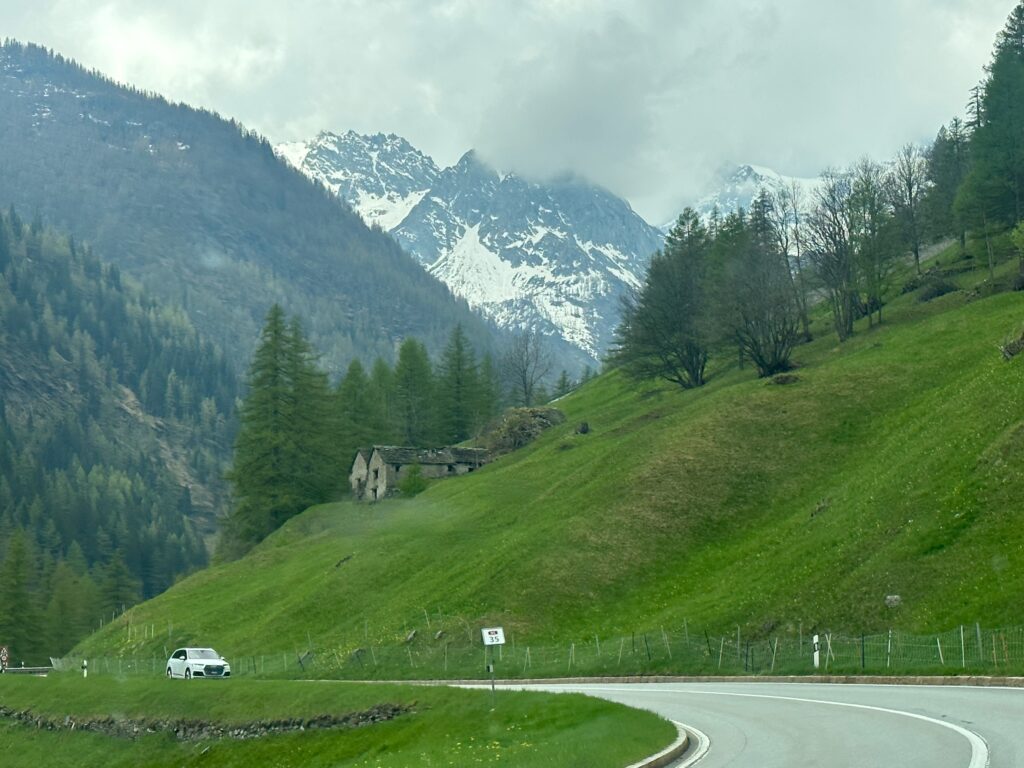
Simplon Strasse/Simplon Pass, Switzerland
The Simplon Pass is essentially between Domodossola and Brig. Just after Brig, to continue onto Interlaken we drive the hairpin bends (nice wide road) up to Goppenstein (Valais) and shortly after drive onto the open car train which takes us through the Lötschberg tunnel (about 12-15 minutes in complete darkness!) to Kandersteg (Switzerland) where we drive off the train to continue our journey. We were able to buy a ticket for the car train just before driving on (around CHF25). Once on the train, you must stay in your car. From Kandersteg it is a very pretty drive to Interlaken.
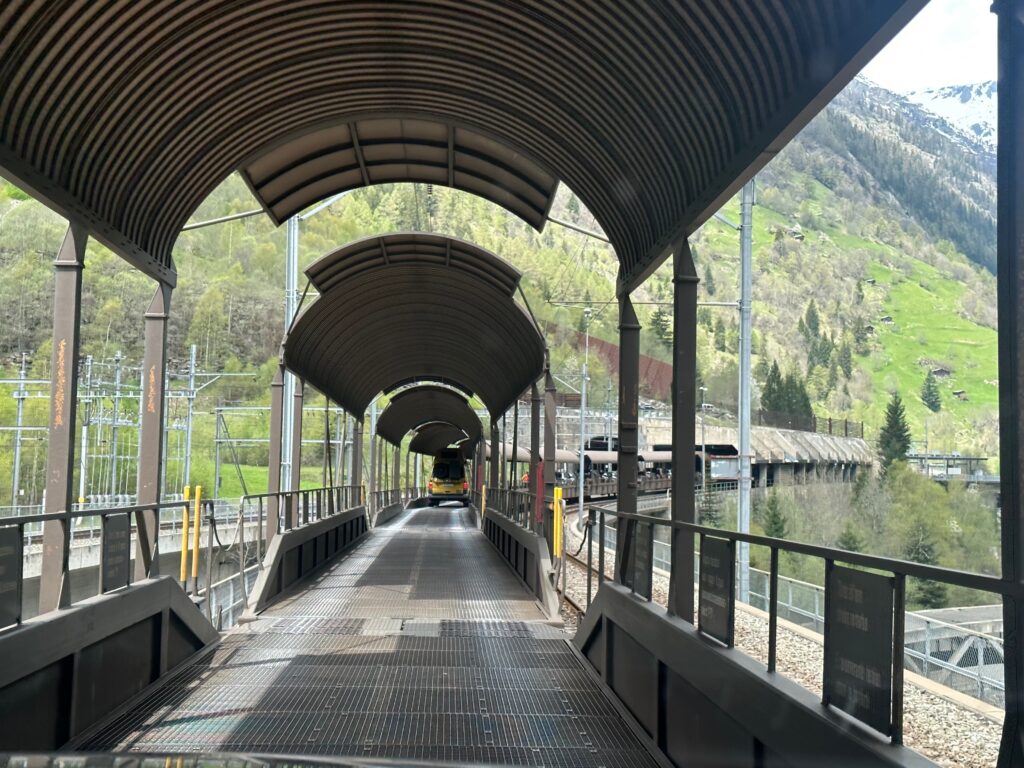
Driving onto the Lotschberg tunnel car train, Goppenstein
For more details on tickets for the Lotschberg tunnel car train see the BLS-Lötschberg car transport service website.
INTERLAKEN, SWITZERLAND
Accommodation: Alphorn Hotel Bed & Breakfast, Interlaken
Accommodation in Switzerland is expensive and this accommodation is just over A$300 a night including breakfast, more than we would normally pay. We have a twin room on the second floor – Room 205. Nice fresh room – not overly large and bathroom very small. It has flat screen TV on wall, bedside tables and lamps and a desk built in at the window with two chairs. Charming host Christine is very helpful.

View of Lauterbrunnen from Wengen
This is a very beautiful area of Switzerland. Popular things to do:
-
- Visit beautiful Lauterbrunnen – many wonderful walks in the area.
- Take the train up to Wengen – a highlight.
- Visit the Schilthorn
- Visit the Jungfrau
- Visit Grindewald
- Take a 10-minute trip on the furnicular to Harder Klum and short walk to the Two Lakes Bridge for views of Lake Brienz and Lake Klum – there are hikes, a restaurant and Swiss folk music in season.
- Take a drive to the charming village of Iseltwald – famous with South Koreans as a film location for ‘Crash Landing on You’ Netflix series.
- Enjoy a meal at Stadthaus in old town Interlaken.

Iseltwald
DRIVE INTERLAKEN TO FUSSEN, GERMANY
It is about a 4.5 hour drive from Interlaken to Neuschwanstein Castle.
We drive through Leichenstein, Austria and into Germany, crossing the Rhine River – beautiful scenery of snow covered mountains, rolling green hills.
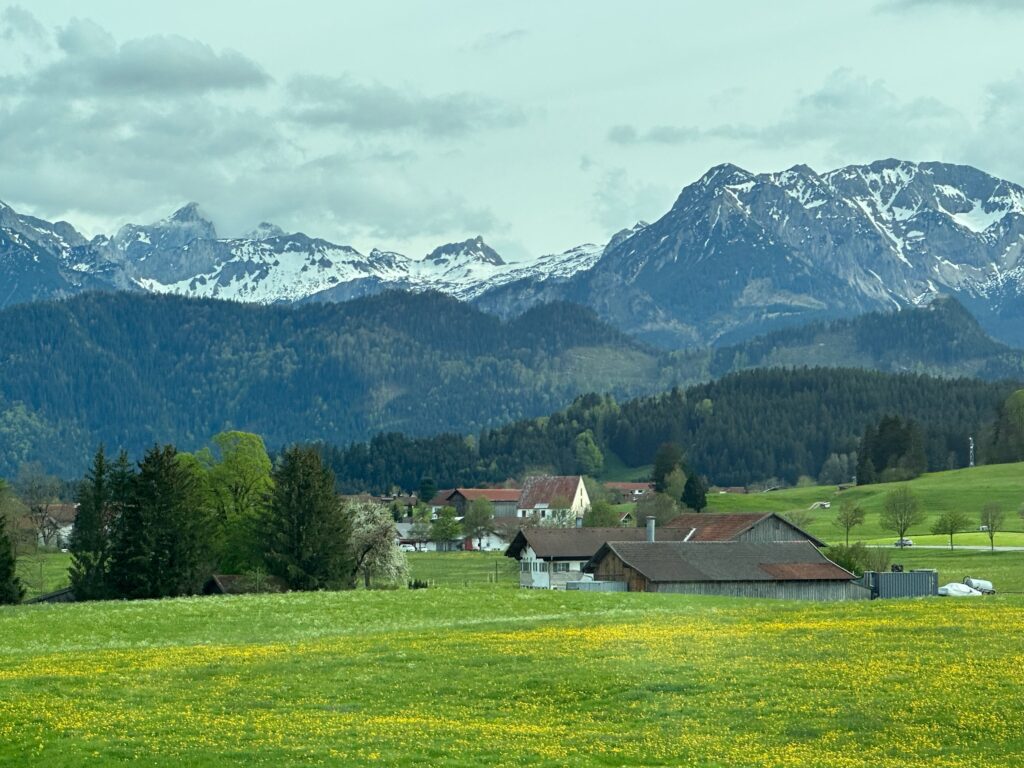
Seeg, Bavaria, Germany
Fantastic road all the way. We have a Swiss freeway pass on our windscreen should we need to pay Swiss tolls. If don’t have the pass, it is a CH200 fine.
NEUSCHWANSTEIN CASTLE, GERMANY
Visits to the famous Neuschwanstein Castle begin in the village of Hohenschwangau.
Neuschwanstein Castle can only be visited on a guided tour. Tickets are available in Hohenschwangau and it is from there visitors can catch the bus up to the Castle.

Neuschwanstein Castle
You can also visit Hohenschwangau Castle and the Museum of the Bavarian Kings.
ROMANTIC ROAD: FUSSEN TO WURZBURG, GERMANY
The Romantic Road is a 350km picturesque route in Southern Germany between Fussen (south) and Wurzburg (north).
We travel the Romantic Road over two very full days. The towns are very beautiful and the countryside between towns is exceptionally scenic with the yellow canola crops in full bloom. We can highly recommend this drive – probably over a few days rather than rush it.
Accommodation:
One night: Trendic Hotel, Frankenstraße 11, 87616 Marktoberdorf, Germany – new, modern, spacious rooms, parking on site, self check-in hotel – highly recommended.
One night: Ferienwohnung Wurzburg, 1 Am Wandberg Erdgeschoß, 97080 Würzburg – a spacious, self-contained, downstairs apartment (under owner’s home), about 6.5 kms from Wurzburg.
Our itinerary: Fussen – Augsburg – Donauworth – Harburg – Nordlingen – Wallerstein – Dinkelsbuhl – Feuchtwangen – Gebsattel – Rothenburg – Wurzburg
Highlights: Fussen, Augsburg, Donauworth, Nordlingen, Dinkelsbuhl, Rothenburg, Wurzburg.
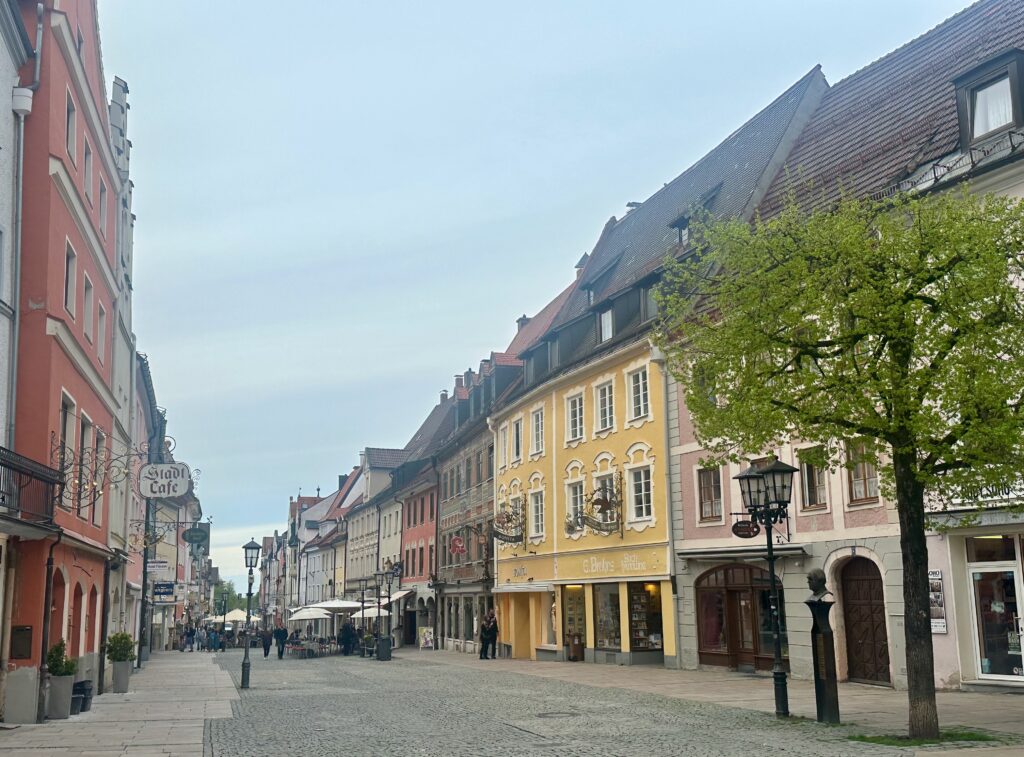
Fussen, Romantic Road

Donauworth, Romantic Road

View of Harburg, Romantic Road

Nordlingen, Romantic Road

Dinkelsbuhl, Romantic Road

Rothenburg, Romantic Road
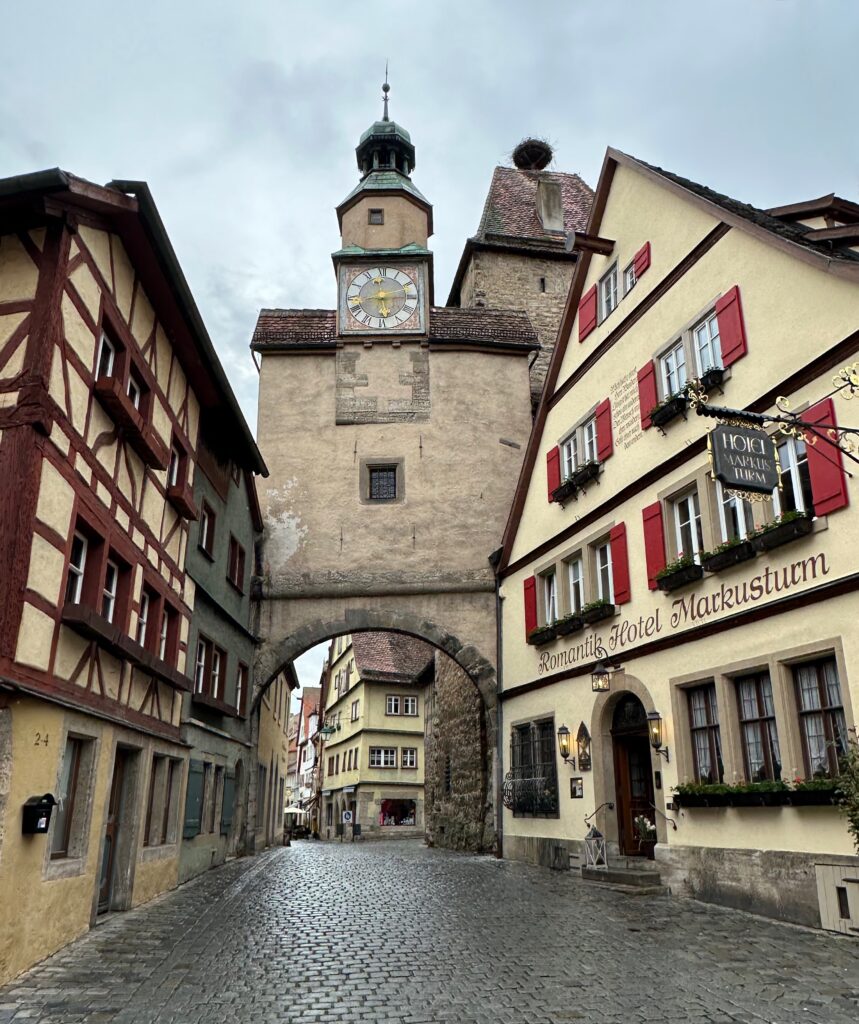
Rothenburg, Romantic Road
WURZBURG, GERMANY
Wurzburg is an historic university town in the Franconian wine region in Bavaria. It is known for its UNESCO World Heritage Palace and gardens.
On our visit to Wurzburg, we park in front of the Palace in an open space carpark. There is a little tourist train leaving from the carpark on a 40-minute tour of Wurzburg (with commentary). Two carriages are for German commentary with the fourth being multilingual.
If not taking the train, it is a few minutes walk into the Old City. We suggest calling into the Tourist Information Office to pick up a map and information on Wurzburg.
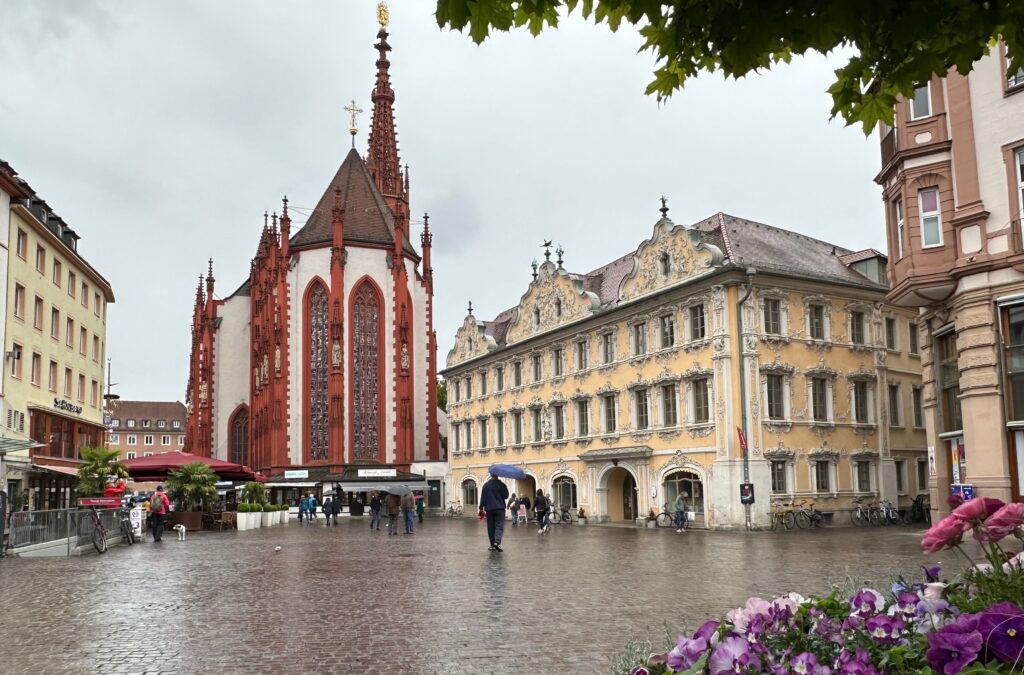
Marktplatz, Wurzburg
Suggested highlights of Wurzburg include:
- Wurzburg Residence & Gardens – UNESCO World Heritage listed Baroque Palace.
- Marienburg Fortress
- Old Main Bridge – beautiful stone bridge over the River Main.
- Wurzburg Cathedral – fourth largest Romanesque church in Germany.
- Visit the famous wineries around Wurzburg.
RHINE RIVER DRIVE: WURZBURG TO KOBLENZ, GERMANY
Leaving Wurzburg we drive to Bingen – beautiful canola crops along the way.
The most scenic section of the Rhine River is said to be between Bingen and Koblenz. We call into the tourist information office in Bingen to pick up a local map, highlighting the villages and castles recommended to see.
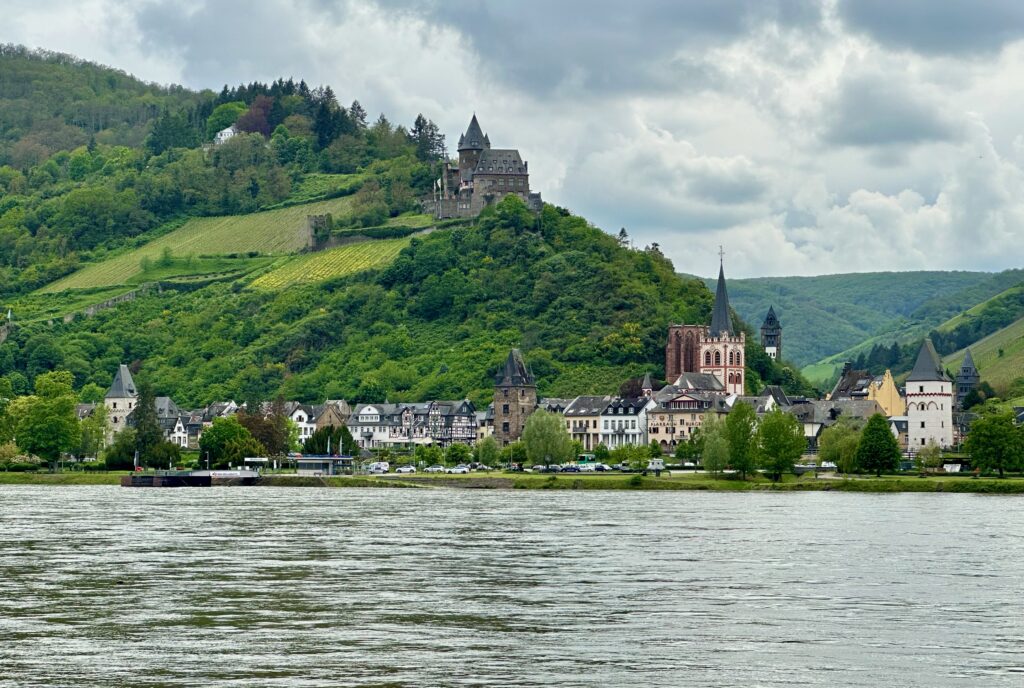
The Rhine River, Germany
From Bingen, driving along the eastern side of the Rhine, the railway line is between us and the river and is very unsightly so we take a car ferry across to the other side of the river (cost 4 Euros). It is a quick crossing as we are at a narrow part of the Rhine. We drive towards Koblenz on the west side of the river which we find more attractive as the road is along the edge of the river (on our left) with the train line on our right. The view of the vineyards and villages across the river look very pretty (probably the more popular side to drive along, but we enjoy the views from our vantage point).
KOBLENZ, GERMANY
Accommodation: B&B Hotel Koblenz, Bardelebenstraße 6, 56073 Koblenz – a two-star hotel, clean, spacious, in walking distance to centre of Koblenz.
Koblenz is a charming town where the Rhine and the Moselle Rivers meet.

Koblenz
Recommended sights:
- The German Corner (Deutsches Eck) – where the rivers meet
- Ehrenbreitstein Fortress (Festung Ehrenbreitstein) – houses the Koblenz State Museum
- Ride the Koblenz Cable Car to the fortress
- Wander the Old Town
STRASBOURG, FRANCE
Accommodation: B&B Hotel Strasbourg Nord Schiltigheim Lac – four-star hotel, very attractive, new hotel about 6 kms from Strasbourg city centre. Parking onsite at hotel in open carpark. From the hotel it is about a 7.5 km drive to the centre of Strasbourg, where we park in the underground carpark in Place Gutenberg.
Strasbourg is a beautiful city – one of our favourites and a must-see. It is a charming, historic city with a unique blend of German and French culture. Two of the city’s neighbourhoods are UNESCO World Heritage listed.
The Grande Ile (great island) is the historic centre of the city and is UNESCO World Heritage listed and features many beautiful historic buildings, squares, shops and restaurants.
The Neustadt (new town) neighbourhood is also UNESCO listed. Neustadt was designed and built in the 19th Century under the German administration. It features wide boulevards, squares, gardens and grand buildings – both public and private.

Petite France
Petite France is one of the most picturesque neighbourhoods in the city and one of the most photographed. It is known for its half-timbered houses, canals, covered bridges and towers which were built to defend the city. It was once an area of tanneries and mills.
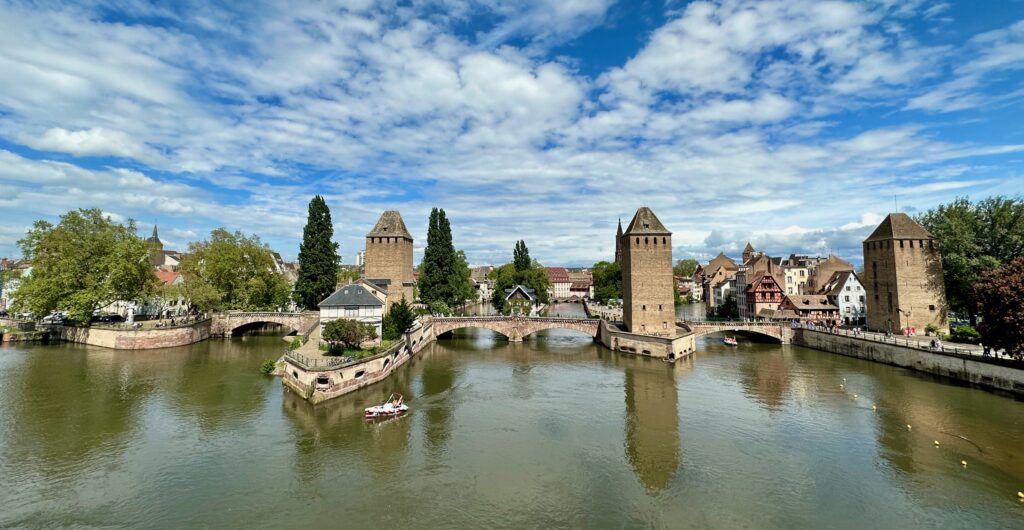
View of former ‘covered bridges’ and defense towers from the Vauban dam.
As an introduction to the city, we took a Free Walking Tour (Free Tour Guide Europe) – highly recommended.
Suggested highlights of Strasbourg:
Grande Ile:
- Cathedral Notre Dame de Strasbourg – the city’s beautiful cathedral dating back to 1015.
- Le Palais Rohan – dates back to 1732 and was originally built as a Bishop’s residence, now houses the Archaeological Museum, Decorative Arts Museum & the Fine Arts Museum.
- La Maison de l’Oeuvre Notre-Dame – dating back to 1347 features the Gothic House & the Renaissance wing. It houses one of the finest collections of medieval art in France.
- Maison Kammerzell – the oldest house in Strasbourg, now a restaurant.
- Place du Marche aux Poissons (Fish Market Square) – where the city’s famous Christmas Market has been held since 1570.
- Place de Marche aux Chochons de Lait (Suckling Pig Market Square) – a charming square in the heart of the city.
- Grande Boucherie (Old Butcher’s House) – beautiful building housing a museum dedicated to the history of Strasbourg.
- La Place des Tripiers – built in 1957 after WWII bombings, has been a place of trade since the Middle Ages.
- Place Kleber – Strasbourg’s largest square
- Stroll down Rue des Serruriers, pass Place Saint-Thomas (see Saint Thomas church and statue of Albert Schweitzer) to Petite France neighbourhood.
Petite France:
- View from Pont Saint-Martin – one of the most photographed scenes in Strasbourg.
- The Ponts Couverts (covered bridges) – three bridges (now built of stone and no longer covered) and towers erected in the 13th century to defend the city
- Enjoy the view from the Vauban Dam (also a covered bridge and weir) – built in the 17th century to defend the city.
- Maison des Tanneurs (Tanners House) – one of the oldest buildings in France, now a restaurant.
For those interested in the European parliament it is possible to visit the parliament in Strasbourg. For more details see the Visiting European Parliament website.

Notre Dame Cathedral, Strasbourg
ALSACE WINE ROUTE, FRANCE
The Alsace Wine Route (Route de Vins D’Alsace) is one of France’s oldest wine routes. It starts northwest of Strasbourg (in Marlenheim) and ends just south of Colmar (in Thann) – around 170kms. It is a beautiful drive through picturesque towns, villages and vineyards.

Route des Vins d’Alsace, Andlau
We drove the route essentially between Strasbourg and Colmar and loved it. Beautiful countryside and picture postcard towns and villages – so many highlights – highly recommended. (I have * the villages that we liked most):
- Obernai
- Mittelbergheim – one of the Les Plus Beaux Villages de France (most beautiful villages of France)
- Andlau
- Itterswiller
- Blienschwiller
- Dambach-la-Ville
- Scherwiller
- Kintzheim – make a detour to see Chateau Haut-Koenigsbourg
- Saint-Hippolyte
- Bergheim – the town of witches
- Ribeauville *
- Riquewihr *
- Eguisheim * Inspiration for animators of Beauty and the Beast.
- Turchheim *
- Niedermorschwihr * – Visit La Maison Ferber, to purchase delicious jams and other treats made by French pastry chef and chocolatier Christine Ferber. Enjoy a meal at Restaurant a l’Ange.
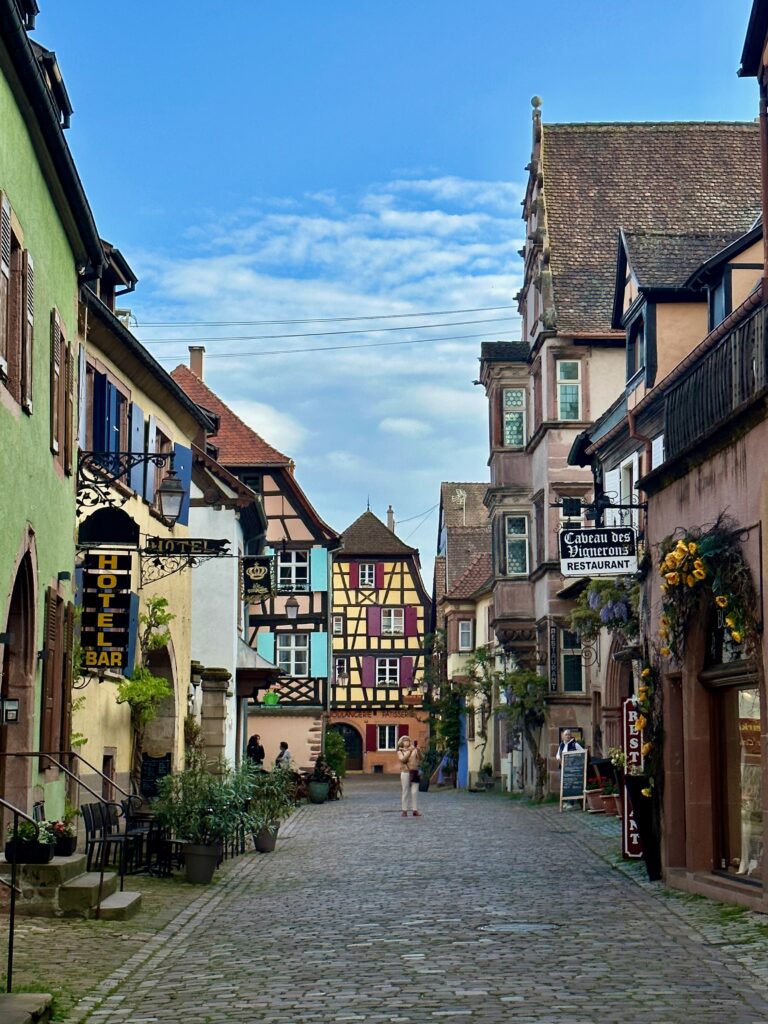
Riquewihr, Alsace Wine Route
For more information on the Alsace Wine Route visit the website, see Visit Alsace – Alsace Wine Route website.
COLMAR, FRANCE
Accommodation: B&B Hotel Colmar Expo
Colmar, located on the Alsace Wine Route is a beautiful place. The old town is particularly beautiful with cobbled streets, pastel coloured half timbered medieval buildings, and early Renaissance architecture.

Little Venice, Colmar
Suggested highlights:
- Petite Venise (Little Venice)
- Quai de La Poissonnerie – the old fishmongers district – now picturesque houses, beautiful place to wander.
- Quartier des Tanneurs (Tanners District )
- Marche Couvert (Covered Market) – lovely food market
- St Martin’s Church (1235-1365), Gothic cathedral
- Unterlinden Museum – medieval, Gothic, Renaissance art, modern art, partly in a 13th century convent, most famous artwork is the altarpiece of Isenheim (1512-1516).
- The Koïfhus or the former customs house – the oldest public building in Kolmar, 1480.
- Pfister House (Maison Pfister) – Colmar’s oldest house, Cnr Rue des Marchands and Place de la Cathedrale, not open to the public.
- Maison des Tetes (House of Heads) – 1609 merchant house, now an upmarket hotel with a Michelin star restaurant.
- Bartholdi Museum – Auguste Bartholdi, the sculptor who designed the Statue of Liberty, was born in this house. The museum presents his work and personal belongings.
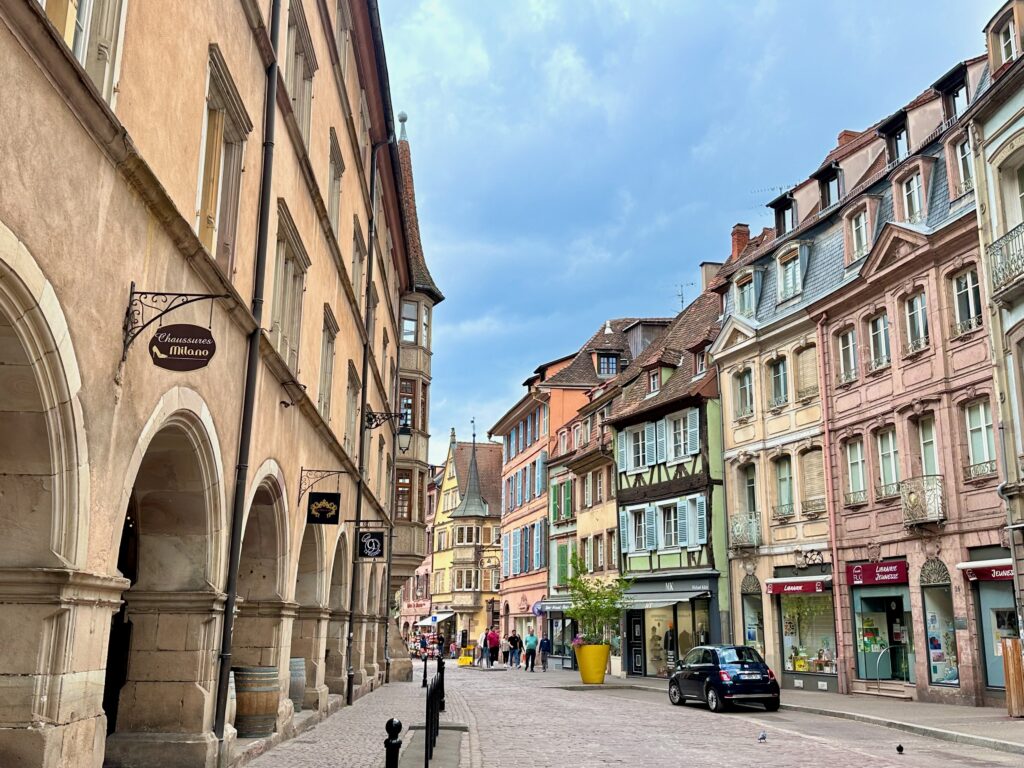
Grand Rue, Colmar
For more information on Colmar, visit the Tourism Colmar website.
COLMAR TO GENEVA, FRANCE
From Colmar, we drove to Geneva to return our car to the Driveaway agent near the airport.
From there we flew to Greece – follow the link for our recommendations.
19 March – 17 May 2023
Best Month of Your Life

